In the heart of the Middle East lies a country that enchants with its fantastic blend of breathtaking nature and rich culture: Oman. The Sultanate of Oman, known as the “Land of Frankincense,” captivated us with majestic desert landscapes, idyllic coastlines, imposing mountain ranges, lush oases, and magnificent historical sites. Not to mention the traditional Arabian hospitality and modern infrastructure.
Rarely has a country captivated us as much as Oman. Away from the glamour and glitter of Dubai or Abu Dhabi, this country scores above all with authenticity, tradition, and progress. The country is still underestimated and certainly not on every traveler’s list. In the following article, we reveal the most beautiful sights in Oman and show you what this country has to offer.
Our Oman tour is by far one of the most beautiful and exciting trips we have ever taken. And who knows, maybe our article can inspire you to give this country a chance. Enjoy browsing!
- Oman Highlights – Overview Map
- Oman Sights in the North
- 1. Capital Muscat
- 2. Daymaniat Islands
- 3. Oasis town of Nizwa
- 4. Jebel Shams & Balcony Walk
- 5. Bahla
- 6. Ruined village of Birkat al Mouz
- 7. Misfat al Abriyeen
- 8. Wahiba Sands Desert
- 9. Wadi Bani Khalid
- 10. Port city of Sur
- 11. Wadi Shab
- 12. Coast between Tiwi and Bimma
- 13. Bimma Sinkhole
- 14. Wadi Al Work
- Oman Sights in the South
- 1. Salalah
- 2. Hawana
- 3. Al Haffa Beach & Coconut Beach
- 4. Mughsail Beach & Blow Holes
- 5. Fazayah Beach
- 6. Wadi Darbat
- 7. Taqah
- 8. Fushi Beach
- 9. Oman Ocean Drive
- 10. Canyon Viewpoint
- Our conclusion to our Oman trip
- Short Oman FAQ
Oman Highlights – Overview Map
On the following map, we’ve marked our favorite Oman sights and highlights. There are no tourist highlights on the route from north to south via the A31. We then drove back north from the south along the coast. There you’ll find some truly stunning landscapes, viewpoints, and beaches. More on that later.
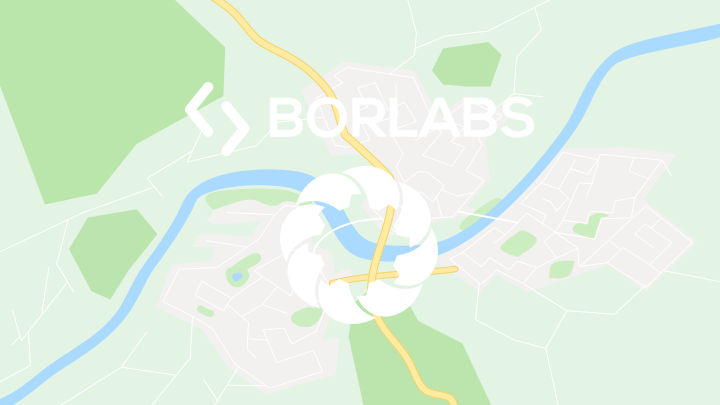
By loading the map, you accept Google’s privacy policy.
Learn more
Load map
Oman Sights in the North
It’s best to first travel through the north of Oman, where the most popular sights and highlights are located. If you “only” stay here, we can assure you that you won’t miss out.
In the north, you’ll find not only golden desert landscapes, picturesque oases, and impressive mountain ranges, but also stunningly beautiful beaches, sleepy mountain villages, and historical sites. Plan at least 7 to 10 days for the north.
1. Capital: Muscat
The capital of the Sultanate of Oman is Muscat. Muscat is not only the political center of the country, but also a cultural and economic heartland that captivated us with its unique blend of modern architecture and traditional charm. The city showcases Oman’s rich history while also being a showcase for development and modernization.
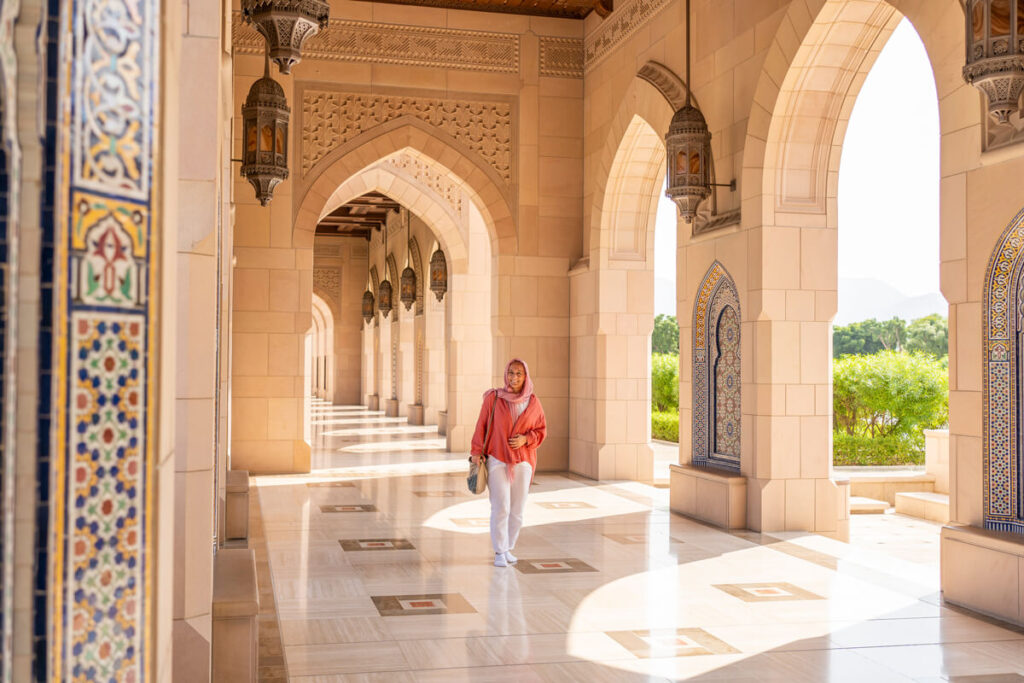
Be sure to visit the Sultan Qaboos Grand Mosque, which is not only an architectural masterpiece but also one of the most important religious sites in the country. You’ll find an impressive main dome, a magnificent prayer room, and an idyllic garden, among other things.
You shouldn’t miss the Royal Opera House, which opened in 2011. We particularly liked the facade, which was clad in pink limestone from the Oman desert. Inside, you’ll find an impressive entrance area and a stunning theater hall.
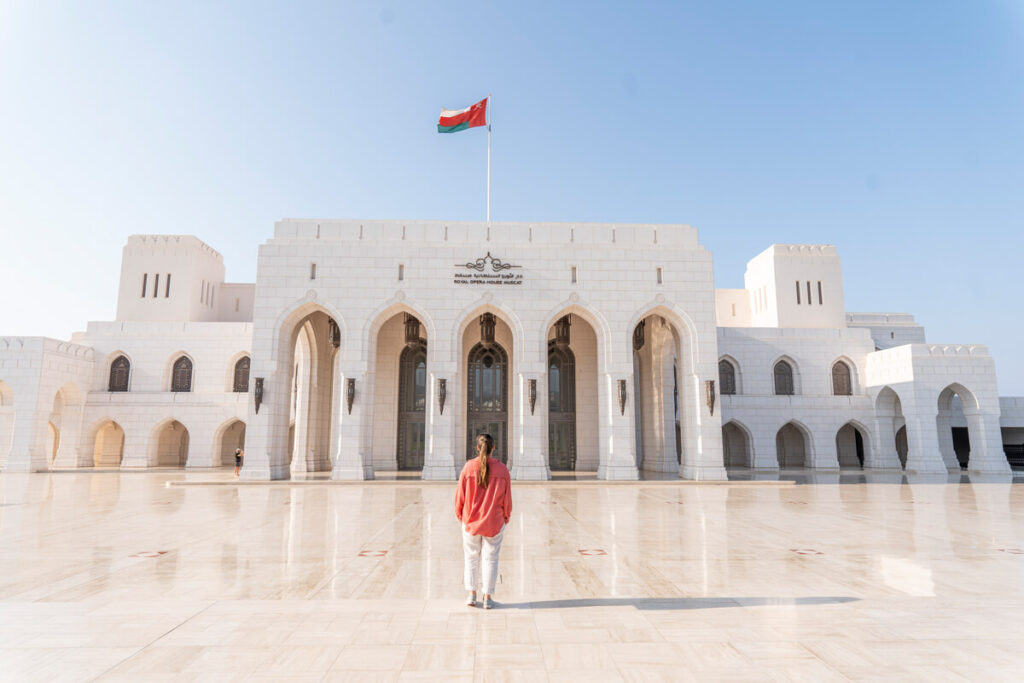
Stroll through the bustling Mutrah Souk, visit the Royal Palace of Al-Alam, and enjoy the sunset from the fortress in Mutrah. We also recommend a walk along Qurum Beach. Muscat, by the way, is a car-driven city and not particularly pedestrian-friendly.
To get from A to B, you should take local taxis, as the distances between the individual sights are usually large. We recommend the two apps OTAXI and Marhaba.

All sights in Muscat at a glance
- Sultan Qaboos Mosque
- Royal Opera House Muscat
- Old Town of Muscat – Muttrah Souk
- Royal Palace of Al-Alam
- Muscat Bay – Muttrah Corniche
- Muttrah Fort
- National Museum of Oman
- Qurum Beach & Qurum Natural Park
- Al Jalali Fortress
2. Daymaniat Islands
Another highlight in Oman is definitely a trip to the Daymaniat Islands*. This archipelago, consisting of nine islands, is located approximately 18 kilometers off the Omani coast and offers a fantastic snorkeling and diving experience. If you visit the country between June and October, you might be lucky and even spot whale sharks in the sea. We saw countless turtles, reef sharks, and many colorful fish. It was an unforgettable experience.
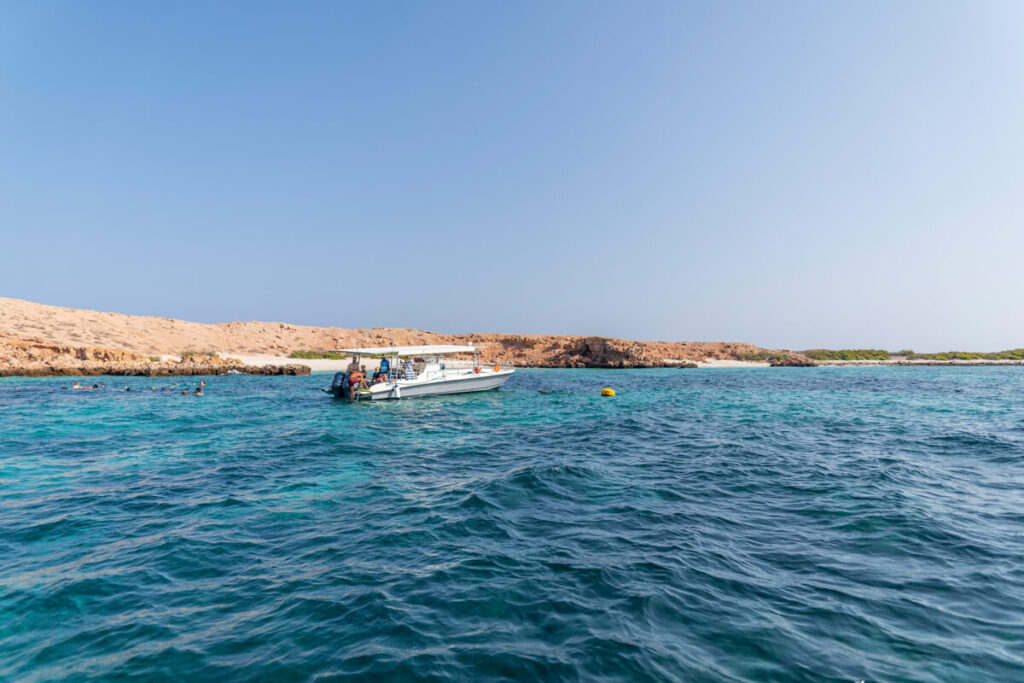
Our tour started at 8:30 a.m. from the port of Seeb (a 25-minute taxi ride). Together with about 12 other guests and two super-cool crew members, we then traveled to the Daymaniat Islands in 30 minutes. On board was excellent snorkeling equipment, soft drinks, water, snacks, and sandwiches. We went to two different snorkeling spots and were even able to go to the larger island. After about 5 hours, we were back in the harbor.
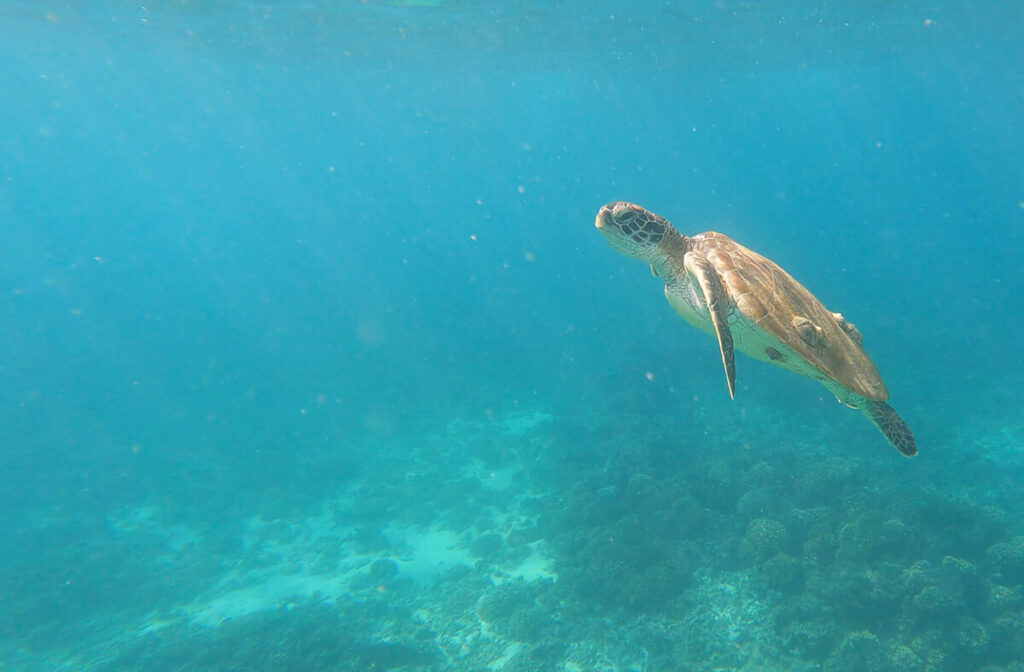
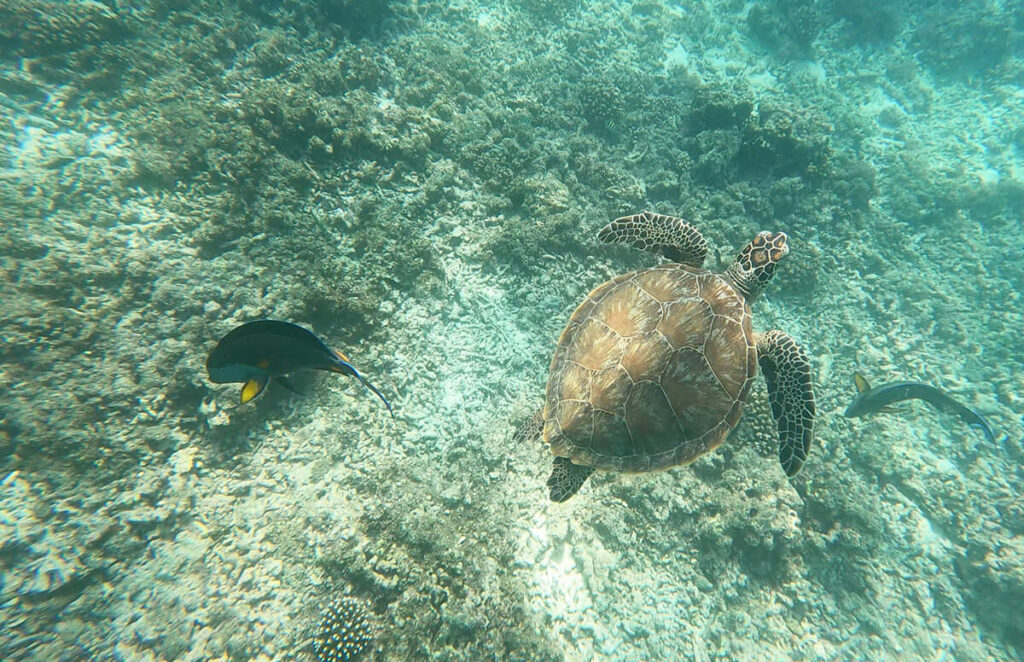
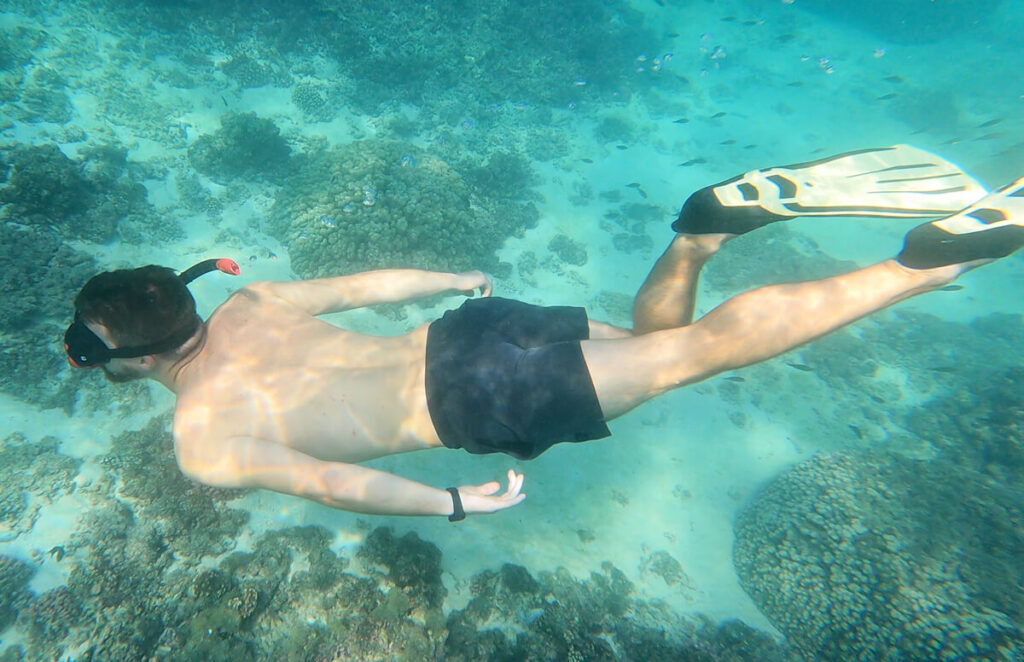
3. Oasis town of Nizwa
After exploring Muscat for three days, our big Oman tour finally began with a rental car (4×4 | Toyota RAV4). Our first stop was the oasis town of Nizwa, which is about a 1.5-hour drive from Muscat.
Nizwa is one of the oldest cities in Oman and has a rich history and cultural significance. Popular sights include the fortress (Nizwa Fort), the beautiful souk, and the surrounding plantations and oases.
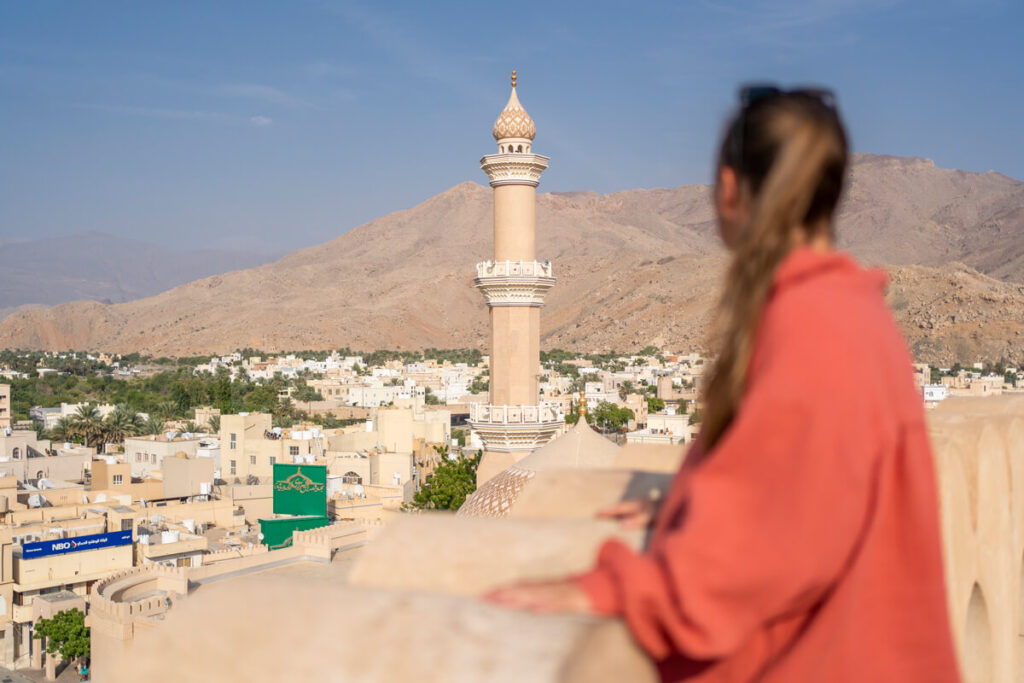
We first ordered a delicious flat white and cake at the Athar Café and let our gaze wander over the fortress. Afterwards, we explored the fort, which was built in the 17th century (entrance fee: 5 rials per person). It is considered one of the most famous landmarks in Oman.
And of course, we didn’t miss the beautiful souk. This traditional market sells a wide variety of goods, including spices, handicrafts, jewelry, dates, and many local products.
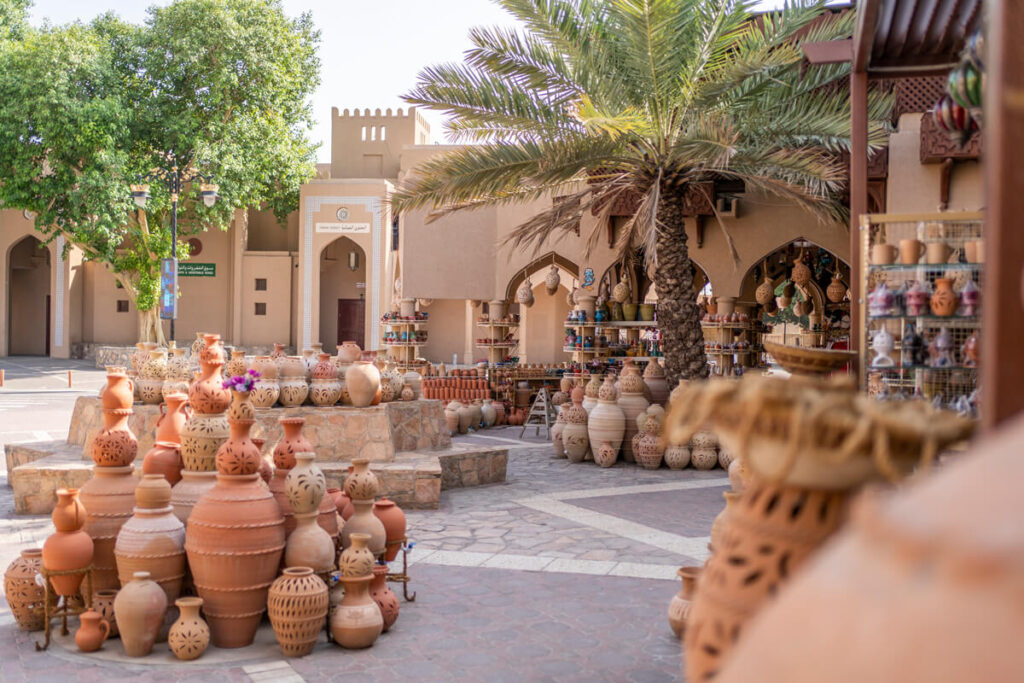
Every Friday around 7 a.m., the famous livestock market takes place in Nizwa. Various animals such as goats, sheep, chickens, and other farm animals are offered there. These markets often provide insight into traditional agriculture and animal husbandry in the region.
We decided against visiting because we didn’t want to conjure up any “unpleasant” images. However, many people told us that it is a very authentic experience and that the Omanis treat their animals very well. Ultimately, everyone has to decide for themselves.
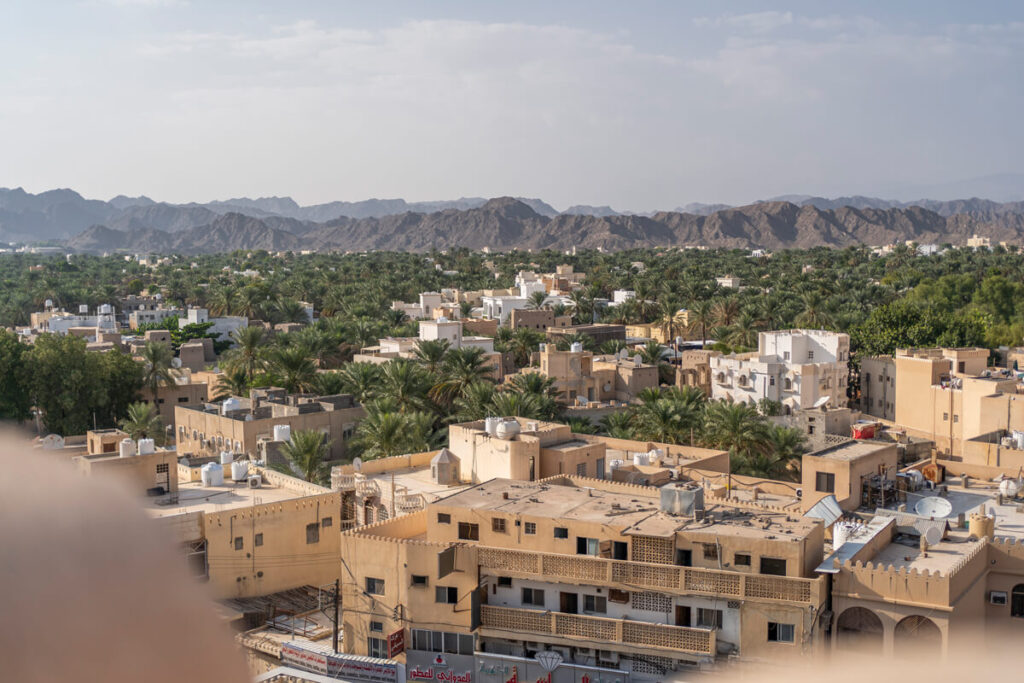
4. Jebel Shams & Balcony Walk
From Nizwa, it’s only a stone’s throw to the mountains. We decided to head towards Jebel Shams, the highest mountain in Oman at 3,009 meters. It is part of the Jebel Akhdar Mountains and just under 245 kilometers from Muscat.
Be sure to go to the “Jebel Shams Viewpoints” and enjoy the spectacular view over Oman’s “Grand Canyon” (Wadi Nakhar). From the viewpoints, the path drops almost 1000 meters. In many places, there are no railings! So, be sure not to go too close to the edge of the canyon.
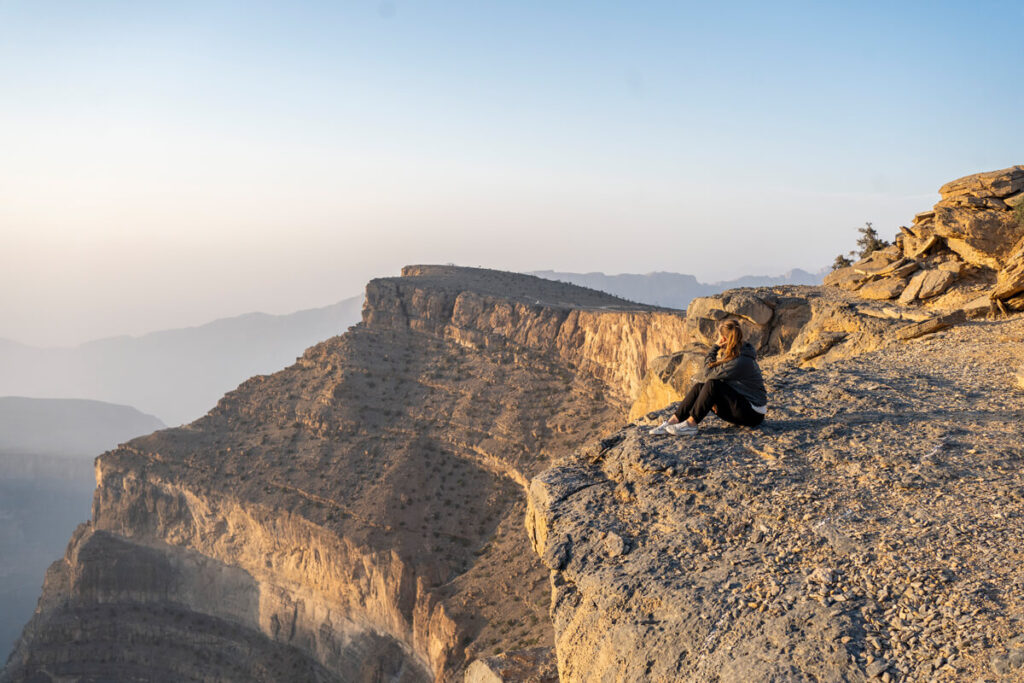
We can also recommend the Balcony Walk (part of the W6 hiking trail), which starts at the end of the road in the small village of Al Khitaym. You can park your car for free in the parking lot, use the restroom, and buy some snacks and drinks there.
The path then continues along the canyon, with some narrow and sloping paths and steep cliffs. Great viewpoints await you along the way.

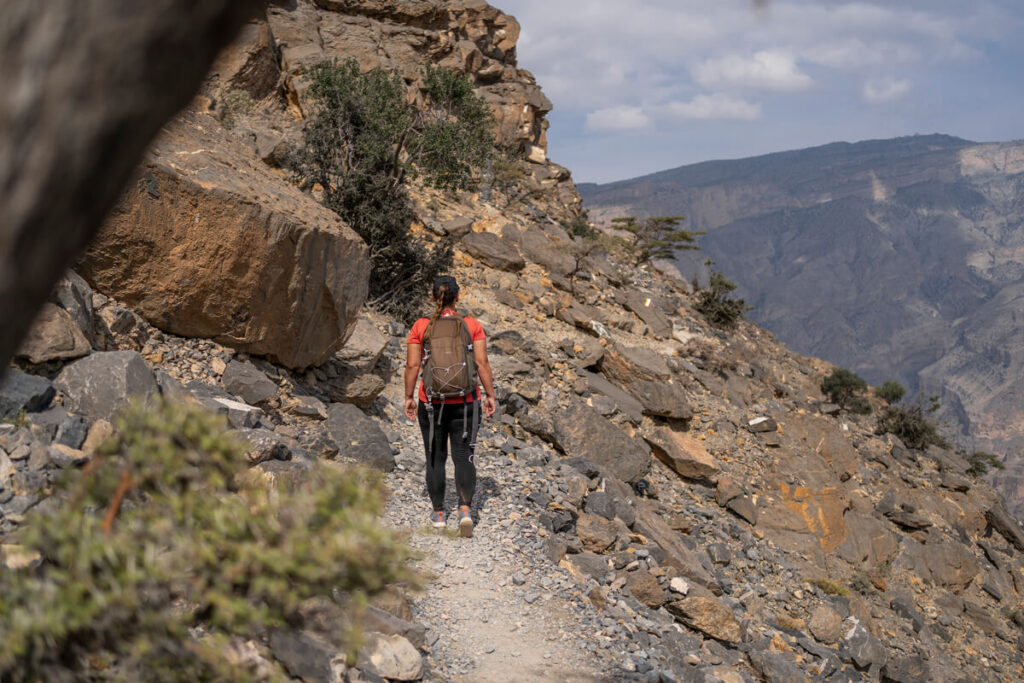
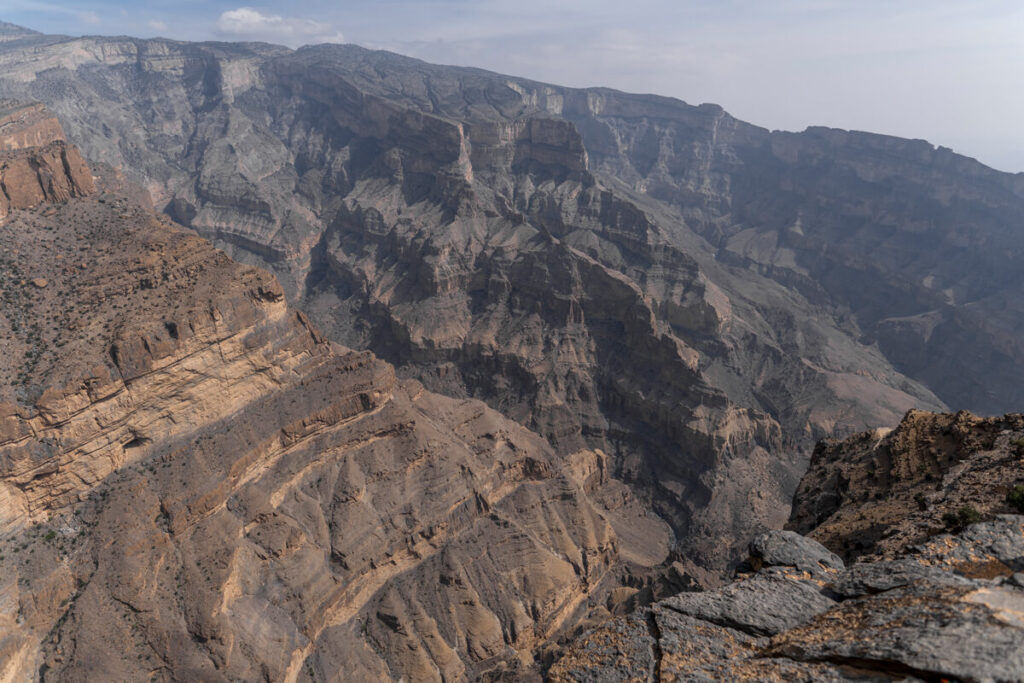
It took us just under 3 hours for the round trip. However, you can turn around at any time along the way and don’t necessarily have to walk all the way to the end. You’ll encounter a few (mostly shy) goats along the way. At the end of the trail is a small hidden pool with a waterfall; perhaps you’ll find it ;).
Be sure to wear sturdy shoes; you’ll occasionally encounter (sometimes slippery) stones and scree. In our opinion, the hike isn’t particularly strenuous; you just shouldn’t be afraid of heights.
Getting to Jebel Shams
First of all: a 4×4 is not necessary. The road is paved almost entirely. Only the last 5 kilometers are unpaved, but it is in very good condition. With a regular car, you’ll probably have to drive a bit slower and more carefully on this track.
From Nizwa, head via Al Hamra and Riwaygh until just before Al Ghayl. Follow the signs to the Sama Heights Resort. From this accommodation (we stayed here for one night, by the way), it’s only 2 kilometers to the first viewpoints and the Cliff Café.

5. Bahla
On our way back from the mountains, we stopped in Bahla. Here, we not only did some shopping and refueled, but also visited the fortress and the original souk. The fort in Bahla is one of the oldest and largest mud fortresses in Oman and was built in the 17th century.
The fortress is on the UNESCO World Heritage List and is an impressive example of traditional Omani architecture (entrance fee: 4 rials per person). Also notable is the almost 13-kilometer-long and up to 5-meter-high city wall, which was built around 600 years ago.
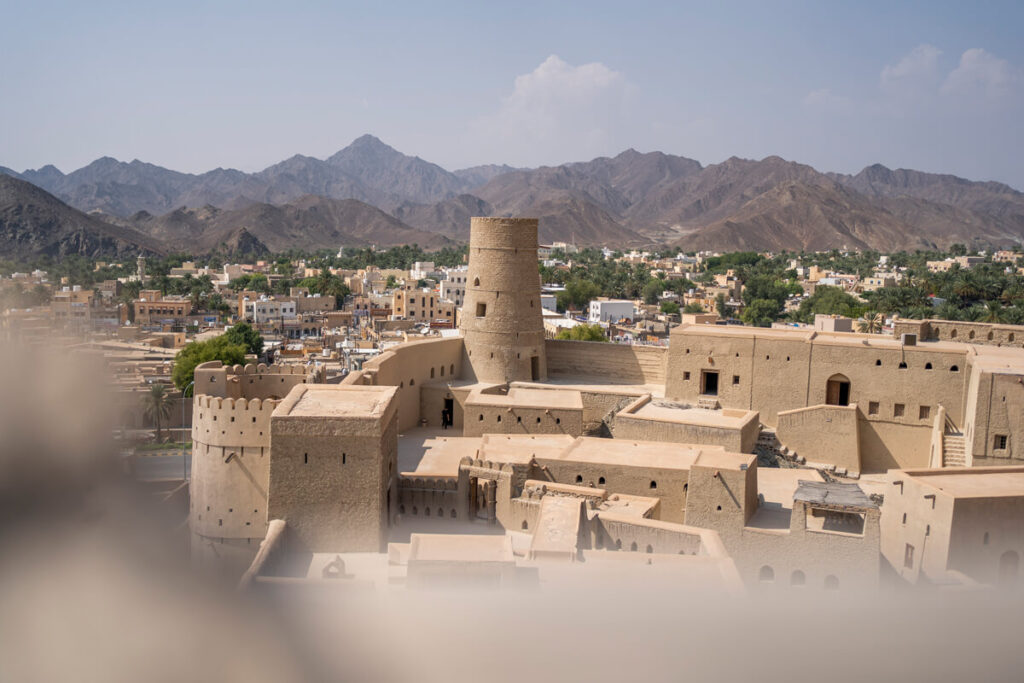
Opposite the fortress is the small souk. It consists of a new part and an old part, which is located further east. The market sells mainly household goods, but also silver jewelry, Omani sweets, basketry, and items made of copper and wire.
We can recommend the Bun ALmdr Roastery café. There you can get delicious cheesecake and very good (and, above all, inexpensive) coffee. Incidentally, every Thursday there is also a cattle market in Bahla, where you can sometimes find very few tourists.

6. Ruined Village of Birkat al Mouz
During our tour through the north, we also took a closer look at the ruined village of Birkat al Mouz. Translated, Birkat al Mouz means “Lake of Bananas” and refers to the extensive gardens and plantations. The old mud-brick village is largely abandoned and is located on a rock above the oasis. These ruins form a striking contrast to the rest of the village.
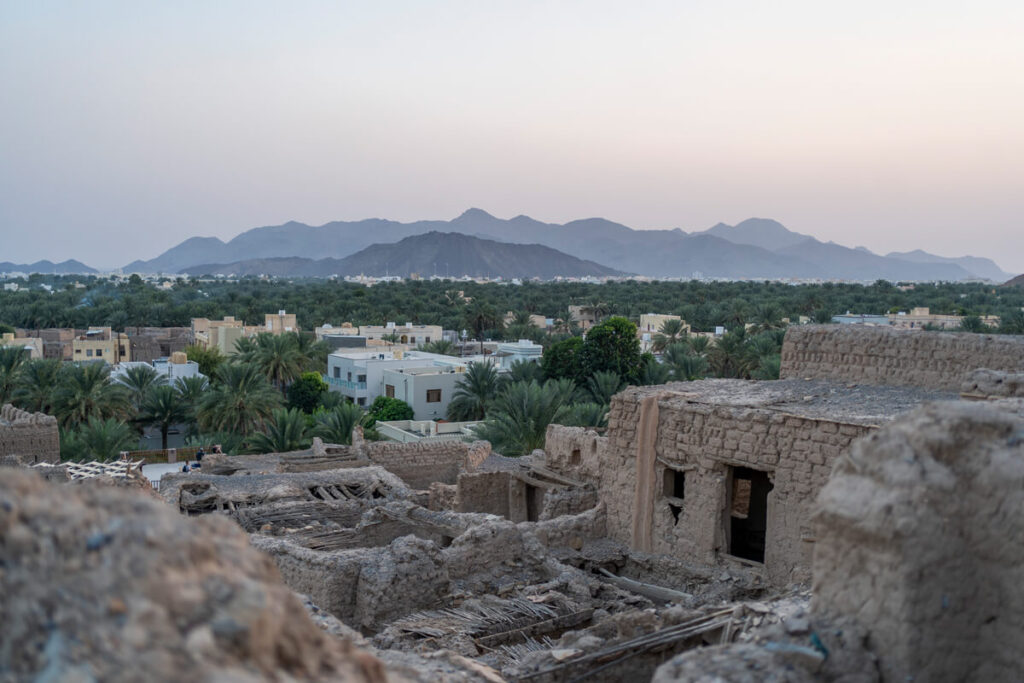
In Birkat al Mouz, you’ll also see the traditional irrigation system, a UNESCO World Heritage Site. For centuries, water has been channeled from the mountains to the individual plantations and gardens via surface and underground canals.
The water is particularly pure and clear and is also used as drinking water by the locals. You can still see locals carrying buckets and canisters on their heads to fetch water, but most households are connected to the water system.
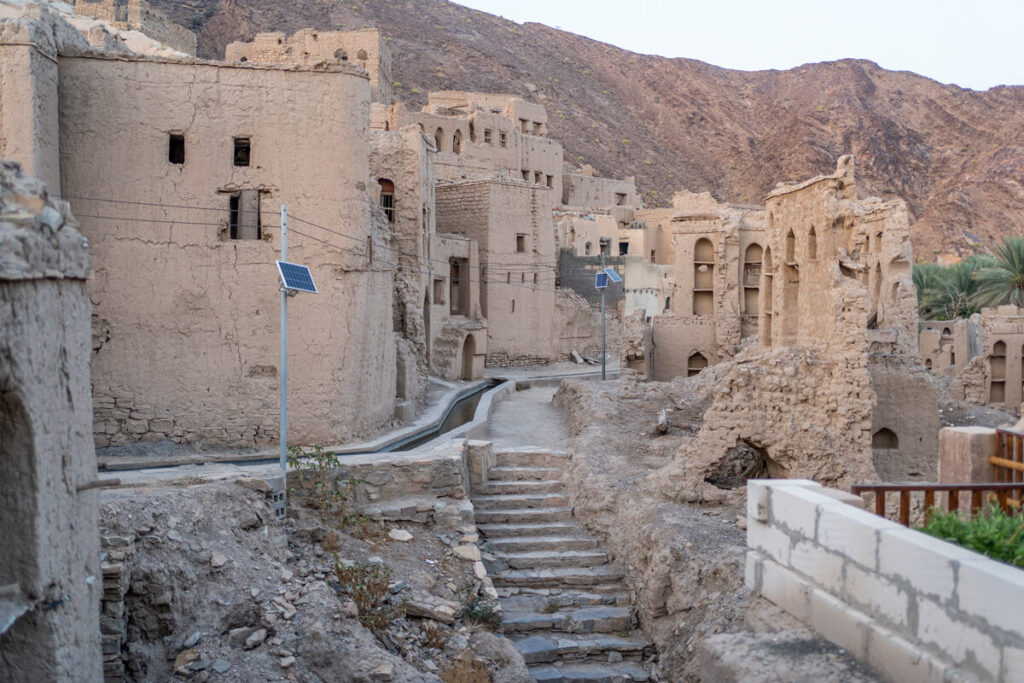
Right next to the ruins is the wonderful Bait AlSabah Heritage Inn & Cafe. It has five individually decorated rooms, a great rooftop terrace with a view of the ruins, and a cute café where you can get excellent coffee. We spent one night there and thoroughly enjoyed the sunset over Birkat al Mouz. A truly exciting and beautiful place. Book a room here*.
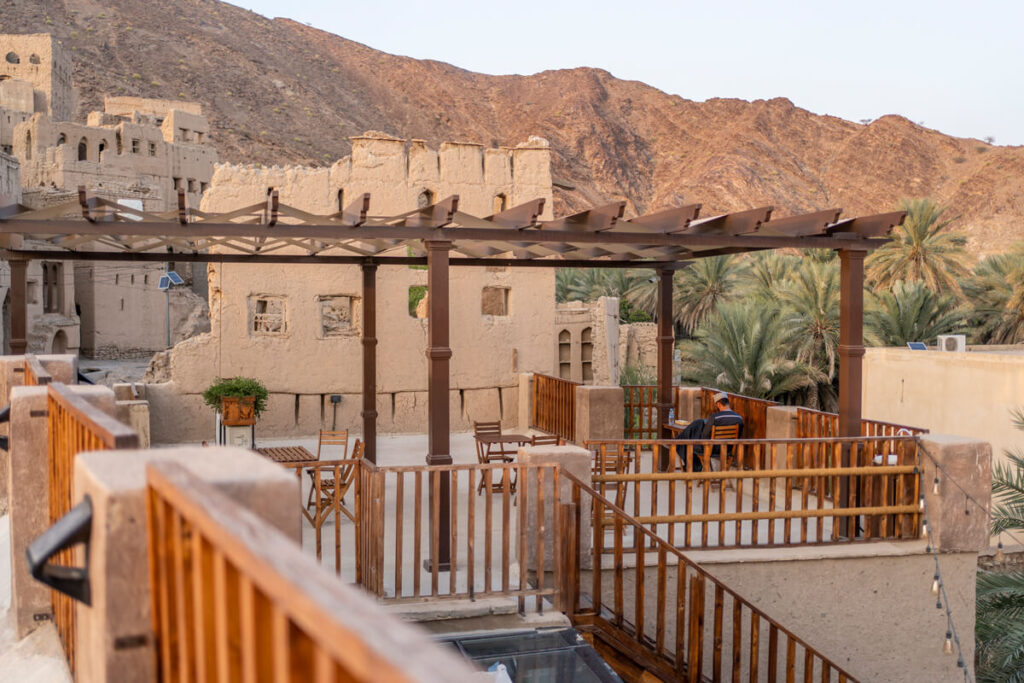
7. Misfat al Abriyeen
We also spent a night in the small mountain village of Misfat al Abriyeen, which lies at an altitude of almost 1,000 m. The village is known for its traditional Omani architecture, consisting of old mud houses with hand-carved wooden doors and windows.
The buildings are often multi-story, have great roof terraces, and reflect the region’s historical architecture. Between the houses, accommodations, and narrow alleys, you will also find abandoned ruins.
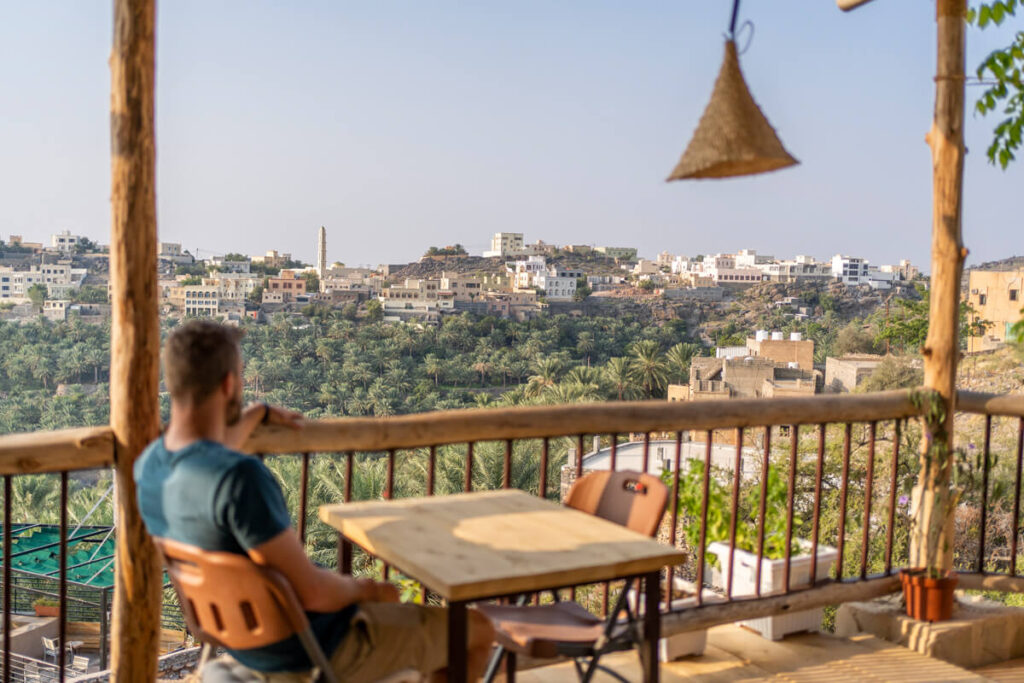
Another special feature of Misfat al Abriyeen are the terraced fields where the residents have been farming for centuries. Date palms and bananas are mainly grown here. Using the traditional irrigation system, also called “falaj,” the people can channel water from the surrounding mountains through underground and open canals to their agricultural terraces and gardens. We highly recommend a walk through the old part of the village.
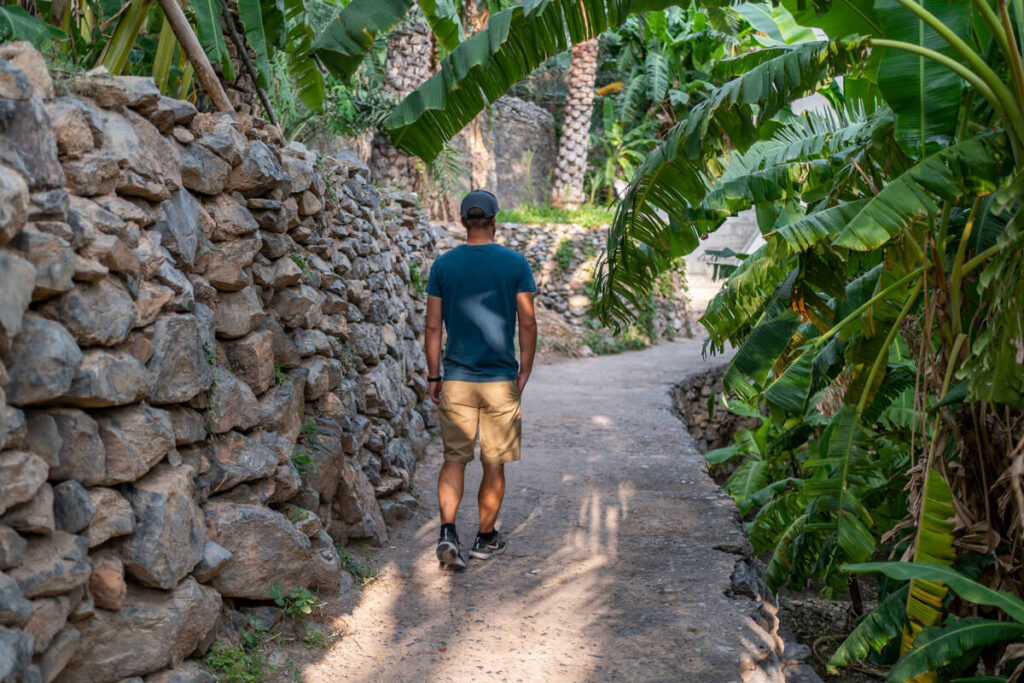
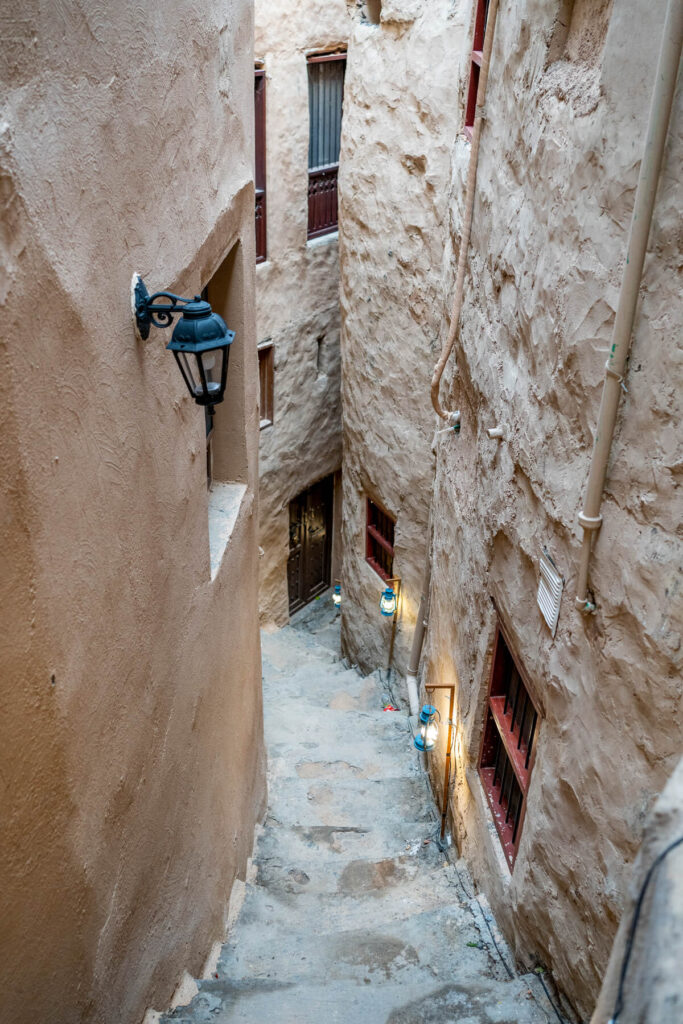
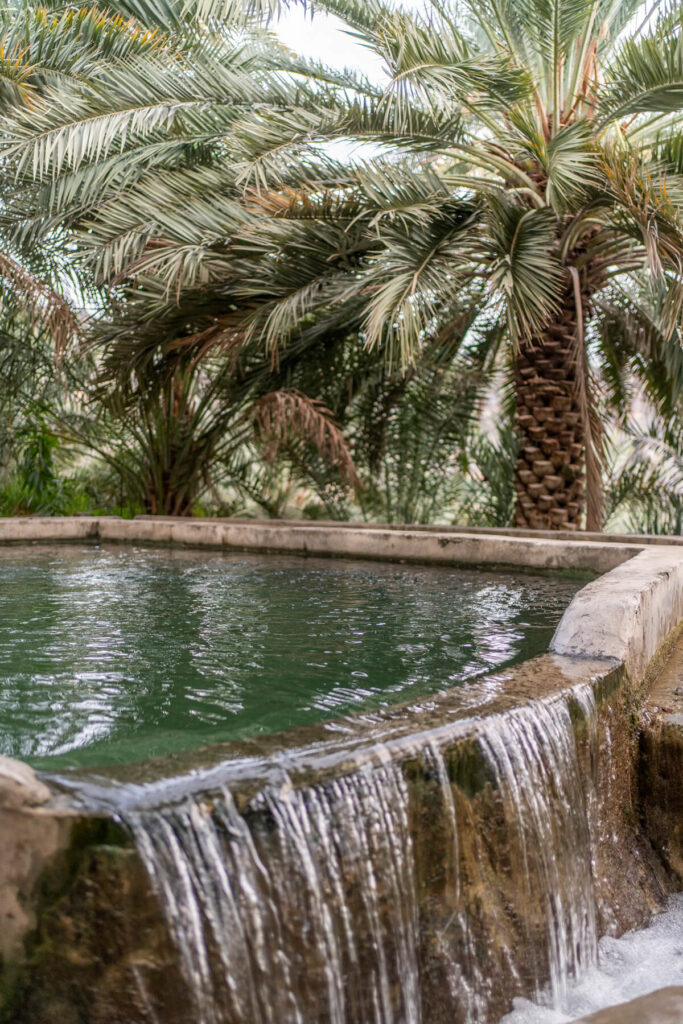
8. Wahiba Sands Desert
You definitely shouldn’t miss the Wahiba Sands! The desert covers an area of approximately 12,500 square kilometers and is located on the east coast of Oman. It is known for its stunning sand dunes, which can reach heights of up to 150 meters.
The color of the sand varies from golden to reddish, creating truly impressive contrasts and a breathtaking view. Just don’t forget to charge your camera batteries beforehand!
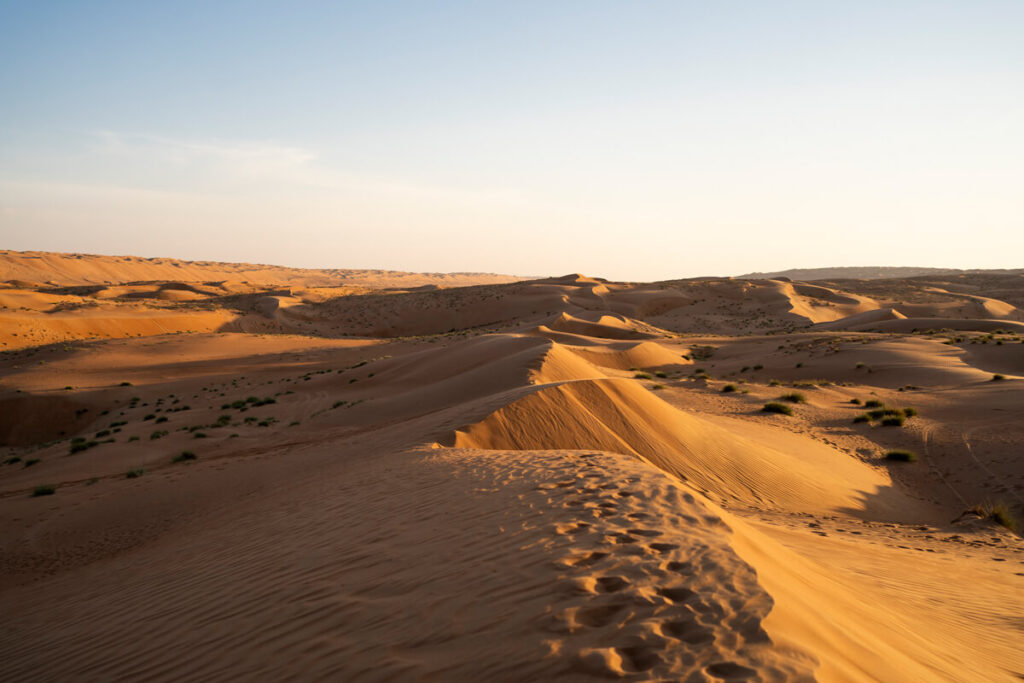
Traditionally, the Wahiba Sands were inhabited by Bedouins who lived as nomads in the desert. Some nomadic tribes still live in this region and lead a nomadic life, although modern influences have affected their way of life.
Today, the desert is, of course, one of the most popular highlights in Oman. Many visitors come here to experience the unique desert ambiance, climb sand dunes, and enjoy the silence of the desert.

We spent a night at the Nomadic Desert Camp and enjoyed the scenery to the fullest. We were particularly impressed by the night sky, which sparkled with thousands of stars above us. Of course, we couldn’t resist taking countless photos of the Milky Way, which we could even see with the naked eye. If you are planning a trip through Oman, you should definitely not miss a stopover in the desert. We recommend 1 to 2 nights.
You can also book popular tours to the desert here:
- From Muscat: Private Desert Safari and Overnight Stay*
- Oman: Wahiba and Wadi Bani Khaled Private Tour*
- 2-Day Private Tour in Wadi Shab to the Wahiba Sands Desert*
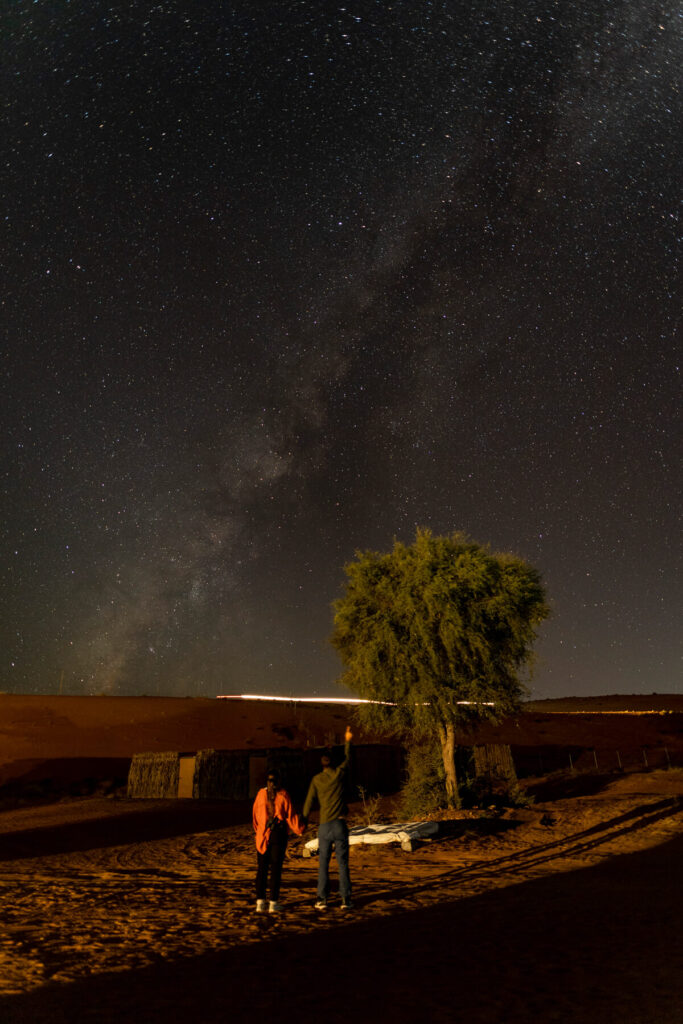
9. Wadi Bani Khalid
One of the top highlights in Oman is Wadi Bani Khalid. It is located approximately 200 kilometers from the capital, Muscat, and is easily accessible from both the coast and the Wahiba Sands desert.
The wadi impresses with its breathtaking landscape, lined with lush green oases, deep rock pools, rugged rock formations, and tall palm trees. The fantastic combination of water, rocks, and palm trees makes it a wonderful destination in Oman.
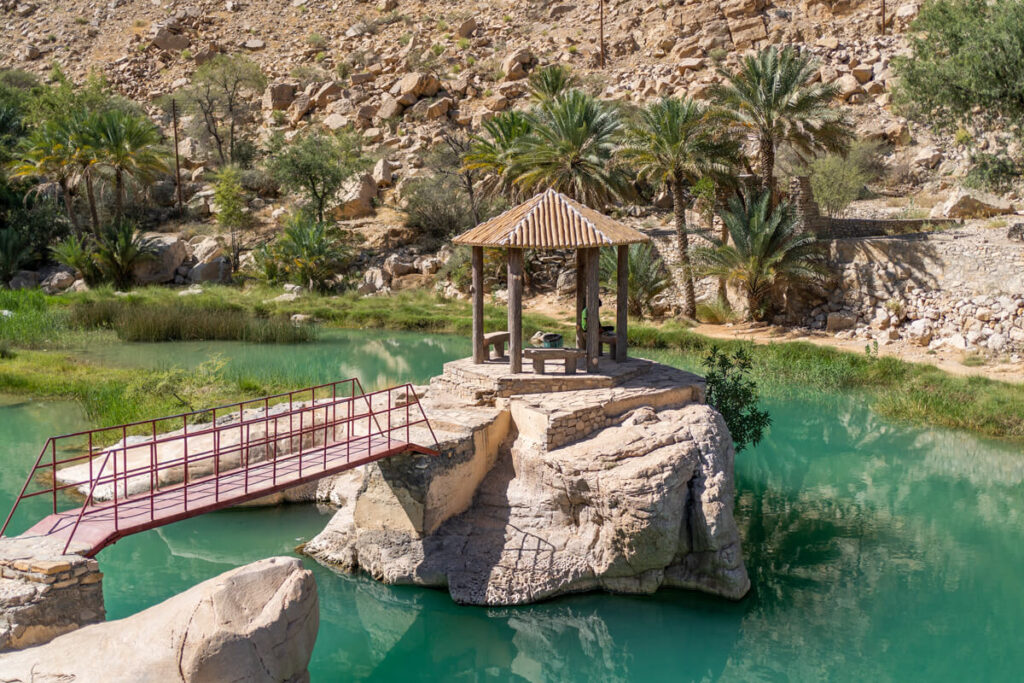
The oasis is known for its permanent springs that flow year-round. The clear, emerald-green pools offer the opportunity to swim and refresh yourself. From the parking lot, you can reach the first large pool and the restaurant in just 5 minutes.
It gets even more beautiful if you head towards Muqal Cave (approx. 1 km). On the way there, you will pass beautiful natural pools. You should be sure-footed and wear sturdy shoes (water shoes* are highly recommended); you’ll occasionally have to scramble over some stones and rocks.
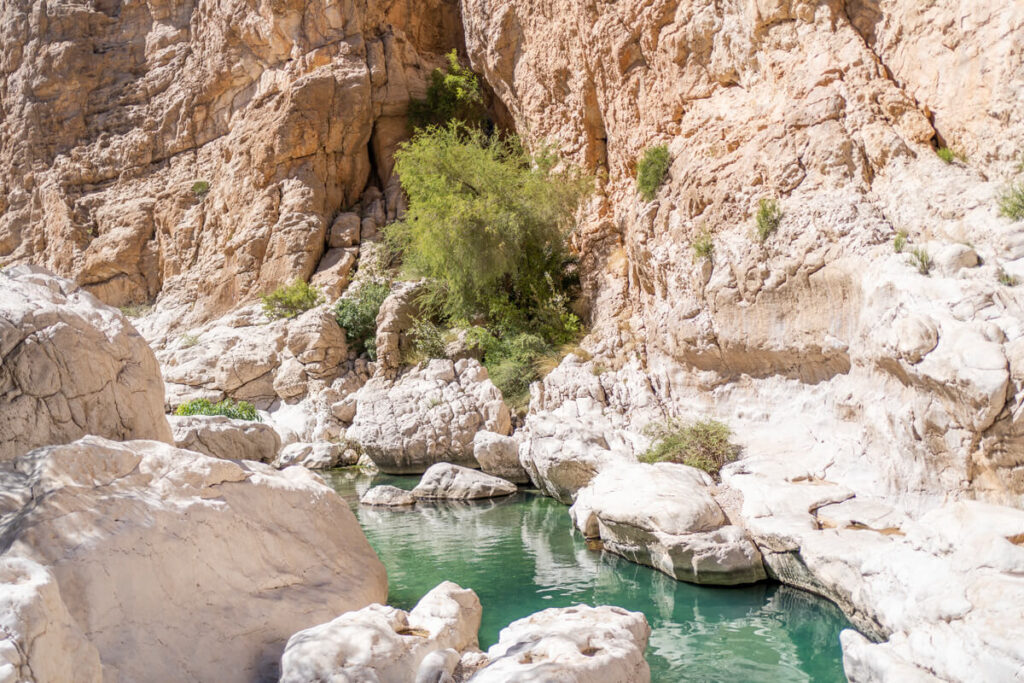
10. Port City of Sur
The small port city of Sur is located on the east coast of Oman, about 200 kilometers southeast of Muscat. Sur has a rich maritime history, was (and still is) traditionally known for shipbuilding and an important center for the construction of dhow sailing ships.
These ships were used for trade and fishing in the Arabian Gulf. On-site, you can watch traditional craftsmen at work in the Dhow Shipyard, where they build these historic vessels, and learn more about the centuries-old tradition of dhow construction.

In the port city is the Sur Fort, also known as Al Ayjah Fort, which sits atop a rock on the coast. It was built in the 16th century and once served to protect the city from attacks. Don’t miss the Al Ayjah Lighthouse, which is best photographed from Sur Beach.
Near Sur is also the Ras Al Jinz Beach, which is known for its turtle watching. Sea turtles come ashore here to lay their eggs.

We took a leisurely stroll along the promenade and enjoyed the beautiful view of the lighthouse, the watchtowers, and the Al Ayjah Bridge on Sur Beach. If you’re in the mood for good coffee and cake, we can recommend the Phenuq Café.
In the heart of the city, you’ll also find the lively market (souk), where you can purchase a wide range of products, such as clothing, jewelry, souvenirs, and household goods. Overall, we found Sur quite charming for a short stopover.
11. Wadi Shab
During our tour of Oman, we also explored Wadi Shab. This wadi is just a stone’s throw from Tiwi and about a 1.5-hour drive from Muscat.
Wadi Shab is famous for its impressive gorge, turquoise pools, imposing rock formations, and lush vegetation. The name “Shab” means “gorge” in Arabic, which describes the topography of this magnificent landscape well.
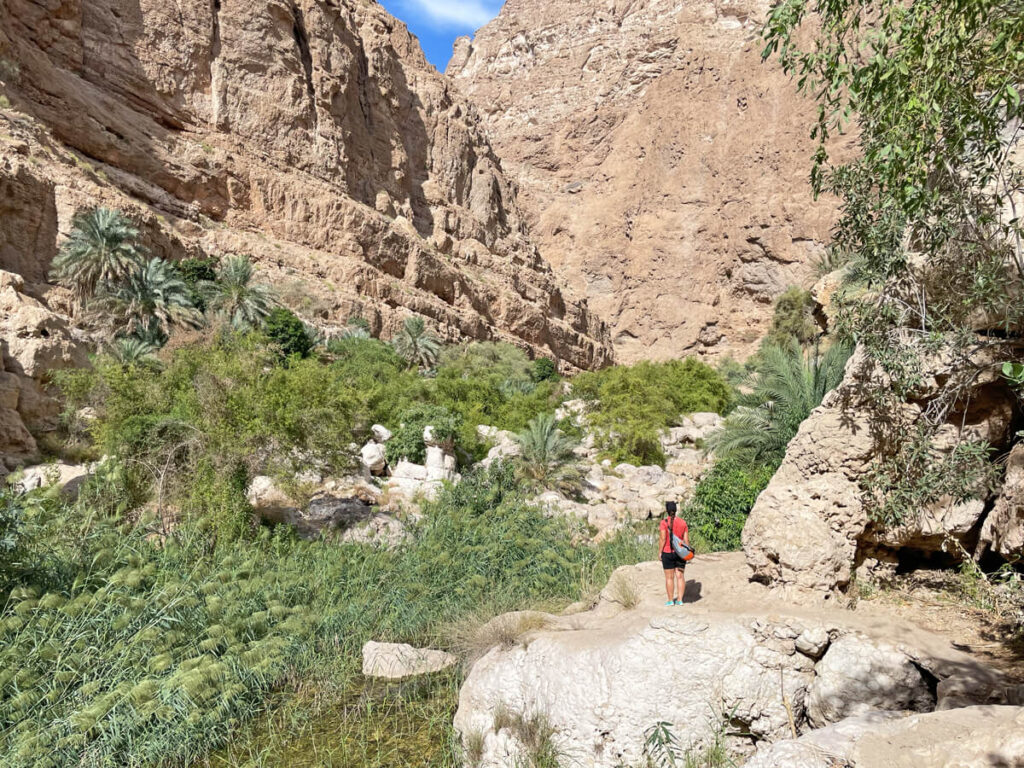
To reach the interior of Wadi Shab, you first have to take a short boat trip across a small river. (Cost: 1 rial per person). After the crossing (approx. 2 minutes), you can start a hike through the impressive gorge. From the boat dock to the first large pool, it’s a leisurely 45-minute walk.
The route leads through rocky sections and finally ends at an impressive waterfall. However, you can only reach this small waterfall if you swim the last bit.
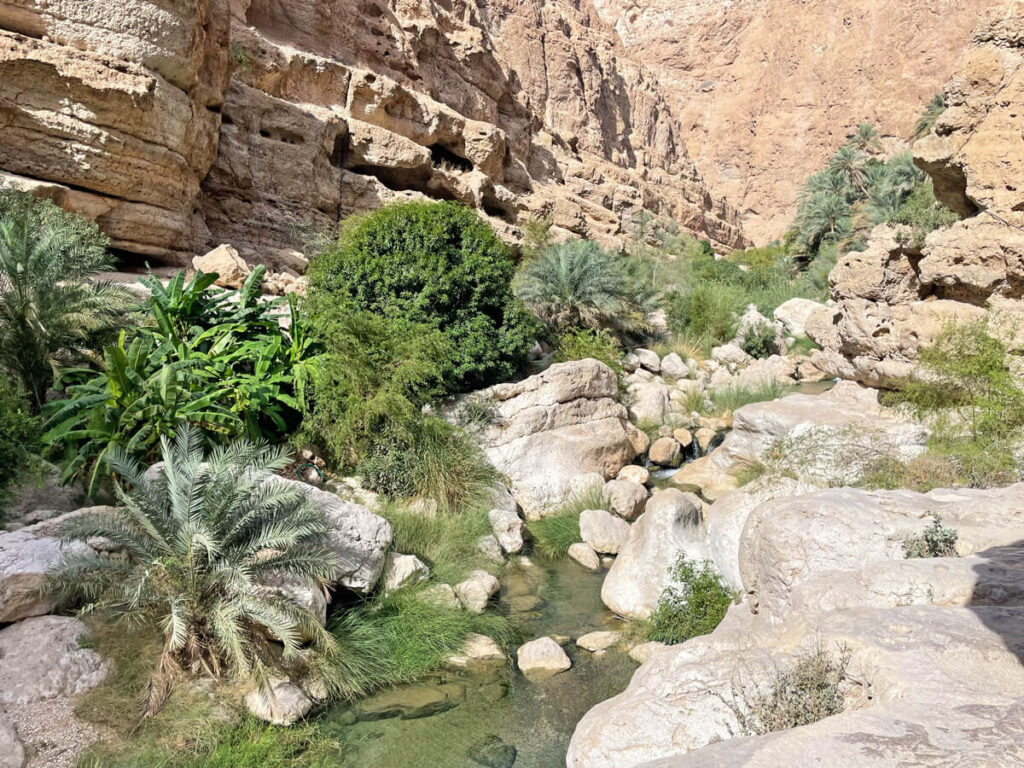
The hike itself is truly worth seeing, as the scenery is breathtaking. Once you reach the pool, you can enjoy the sun and cool off in the water. If you want, you can swim into the cave (approx. 300-400 meters).
Shortly before the cave, you have to go through a very narrow crevice. Water shoes* are highly recommended on this tour. These allow you to walk unhindered through the gorge and also through the water. Really very practical!
Visitor Information Wadi Shab
- Price for the boat trip: 1 rial return per person
- Times: Boats run from 7:30 a.m. to approx. 5:30 p.m.
- Parking: in front of the jetty, free of charge
- Wadi Shab Café: snacks, coffee, cake, drinks
- Packing list: sunscreen, water shoes, dry bag for valuables, towel
- It’s best to come early in the morning when it’s not so busy!
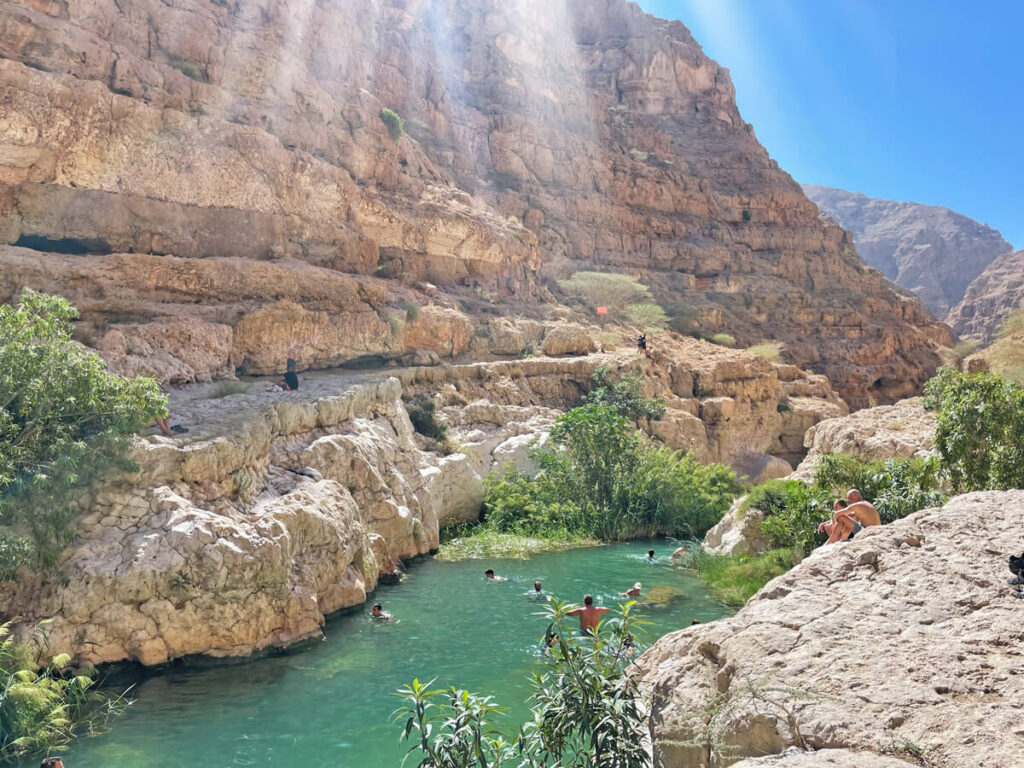
12. Coast between Tiwi and Bimma
Between Tiwi, Fins, and Bimma, you’ll find beautiful stretches of coastline, beaches, and bays. We also noticed the many “camping sites” right by the sea, which are also marked on Google Maps.
On your way from Wadi Shab to Muscat, you can stop here and there, jump into the sea, and enjoy the great weather. We can recommend, among others, the “White Sand Beach” and the “Hidden Beach” just before Bimma.
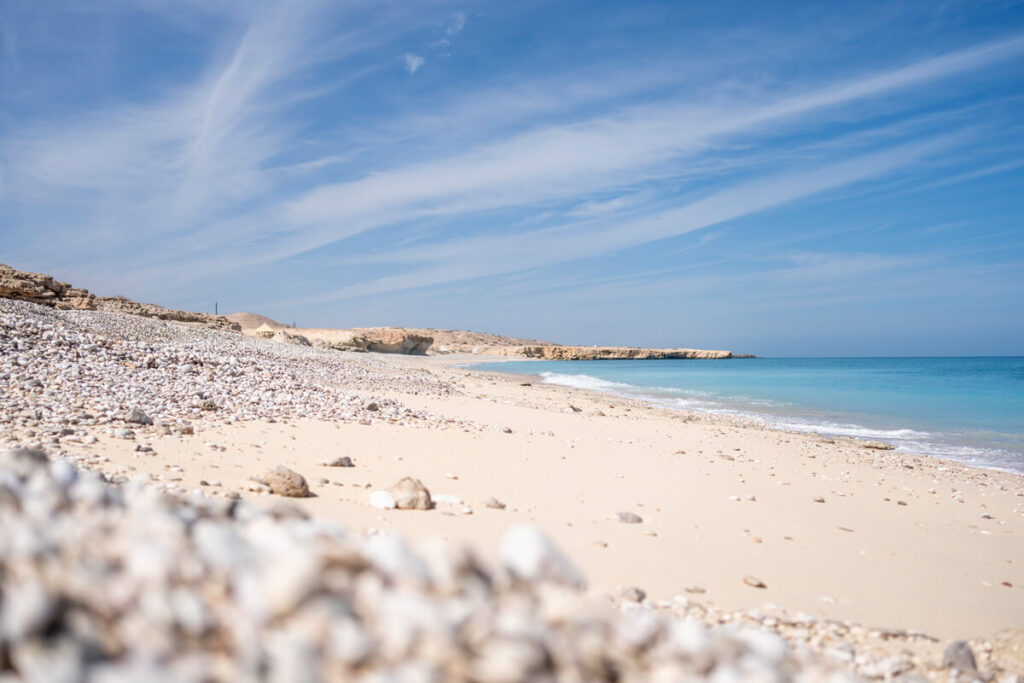
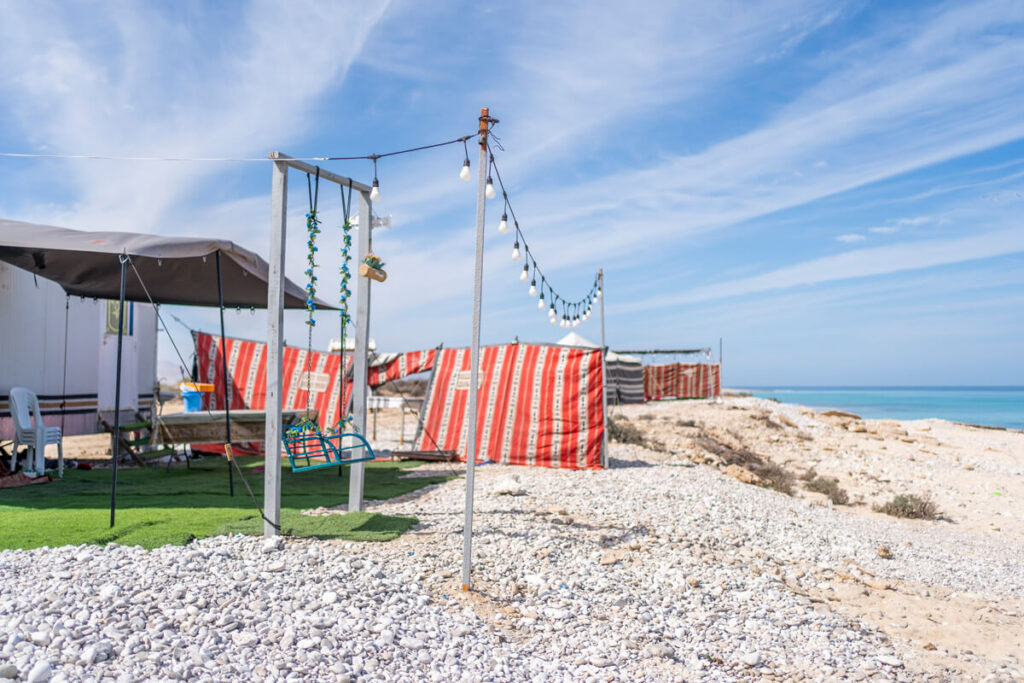
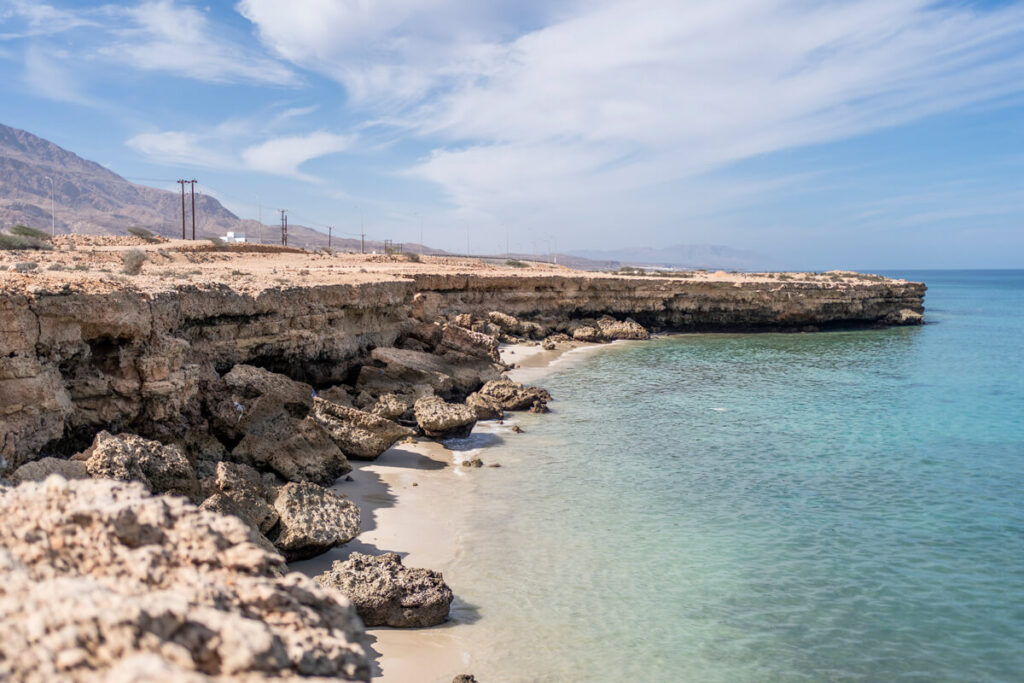
13. Bimma Sinkhole
The Hawiyyat Najm Sinkhole, also known as the Bimmah Sinkhole, is a natural geological rock formation in Bimma. The hole was created by the collapse of the overburden and forms an impressive crater with steep walls.
This so-called “sinkhole” is connected to the sea via a cave system, which is why the clear, turquoise water is also salty. The special thing about the Hawiyyat Najm Sinkhole is that swimming is permitted on site. The water surface has a diameter of about 40 meters and from the crater rim you can see almost 20 meters into the depths.
Visitor Information Bimmah Sinkhole
- Address: Dabab Sinkhole هوية نجم, Dibab, Oman
- Opening hours: daily from 8 am to 8 pm, Fridayags until 9 p.m.
- On-site: Restrooms, playground, benches, picnic areas
- Price: Admission is free
- Our opinion: You won’t miss anything if you haven’t seen it!
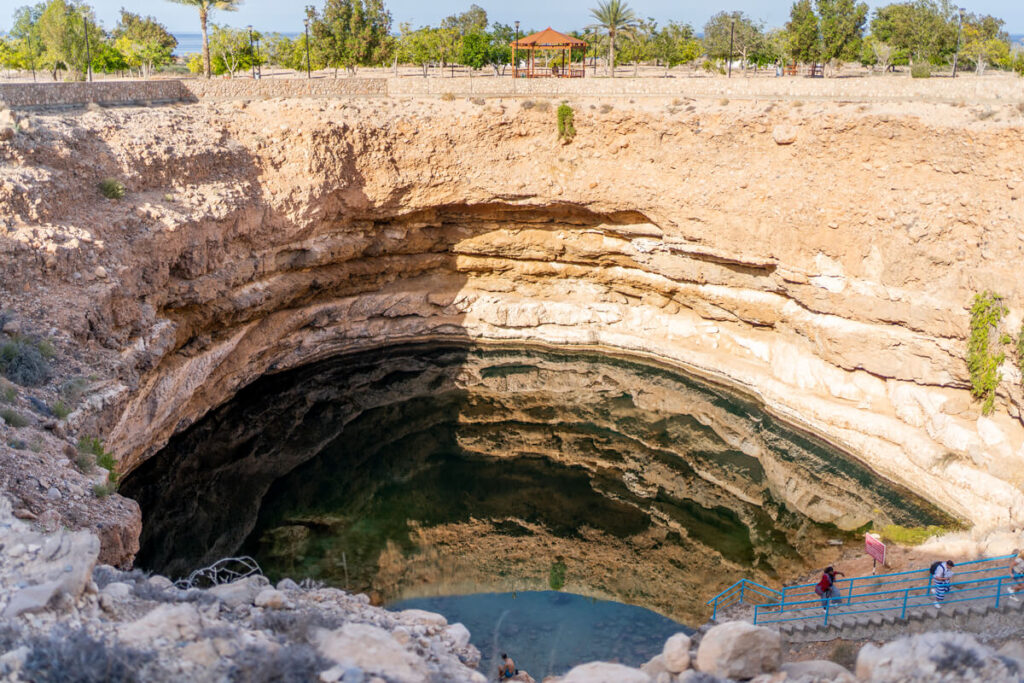
14. Wadi Al Arbeieen
We spent the last day of our trip in the idyllic and incredibly beautiful Wadi Al Arbeieen. This wadi is about 130 km from the capital and scores above all with its seclusion and unique scenery. It is surrounded by an impressive mountain landscape characterized by steep cliffs, green palm groves, and rocky formations.
The wadi is also known for its natural pools, where water collects from the surrounding mountains. These pools offer a refreshing opportunity for swimming and relaxation. Caution! Only drive through the wadi with a 4×4!
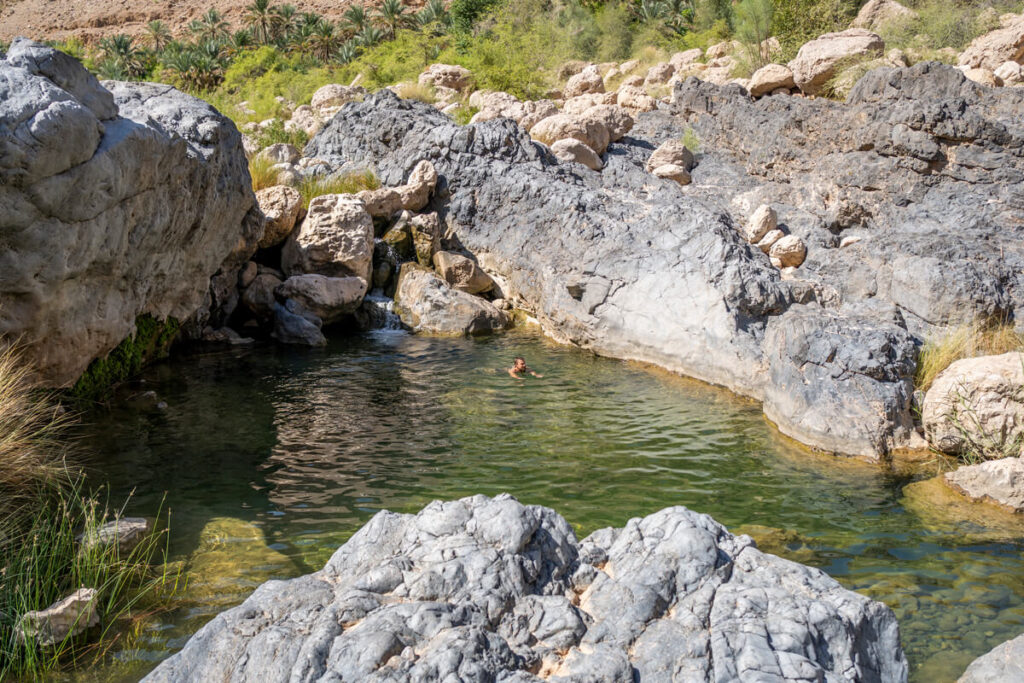
We spent the last night at the Wadi Al Arbeieen Resort, which is easily accessible by off-road vehicle. From there, it’s just a stone’s throw to a smaller waterfall and the picturesque pools.
You can also take a challenging hike to a hidden waterfall, but you should plan on about 10 hours for this. Please also note that some parts of the wadi may be difficult to access during the monsoon season due to flooding.
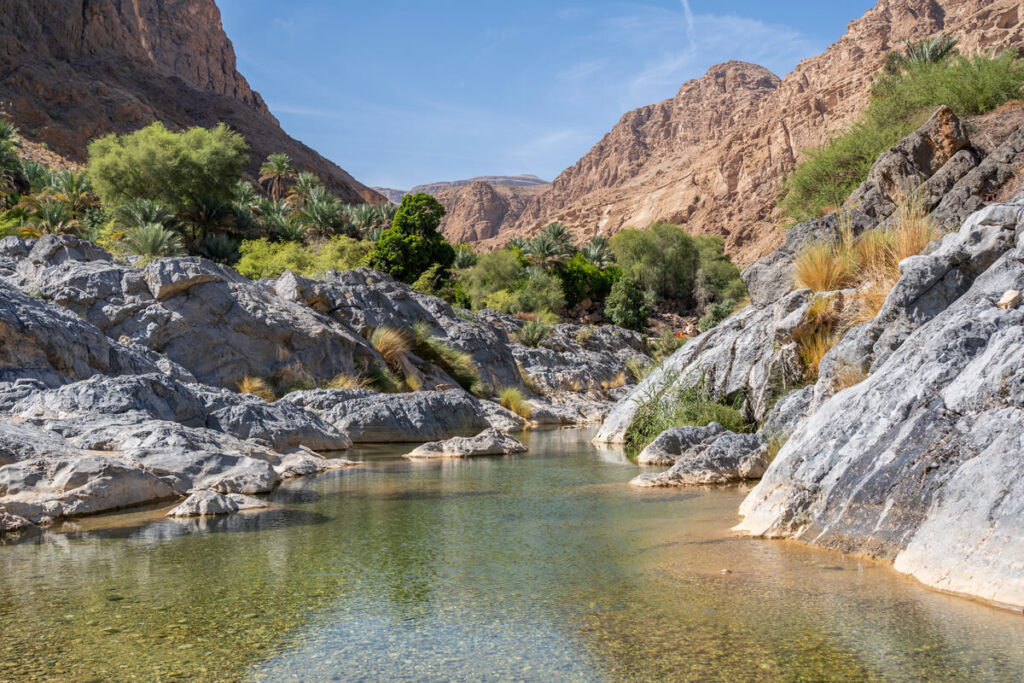
Oman Sights in the South
If you have a little more time for your tour, we also recommend a detour to the south of the country. While we covered the almost 1,000 km by car, others took a comfortable domestic flight from Muscat to Salalah.
So you can decide whether you want to travel to Salalah by rental car, bus, or plane. Some even start their trip in Muscat, then drive down south on their own and fly home from Salalah.
Southern Oman is known for its unique climate. During the monsoon season, also known as Khareef, the landscape transforms into lush green valleys, which contrasts sharply with the dry desert areas in the rest of the country. The Khareef season typically runs from June to September and brings cooler temperatures and humid weather.
However, this time of year attracts a huge number of visitors from surrounding countries who come to enjoy the green landscape and pleasant temperatures. We recommend at least 4 to 5 days for the south.
1. Salalah
Salalah, the capital of the Dhofar region in southern Oman, is a popular destination, especially during the Khareef season. During this time, the region transforms into a green oasis. But even outside of this season, Salalah delights with beautiful beaches, palm groves, and lively markets.
The surrounding area offers a unique mix of picturesque coastlines, green hills, palm trees, and waterfalls – a striking contrast to the otherwise arid landscape of Oman and definitely worth a visit.
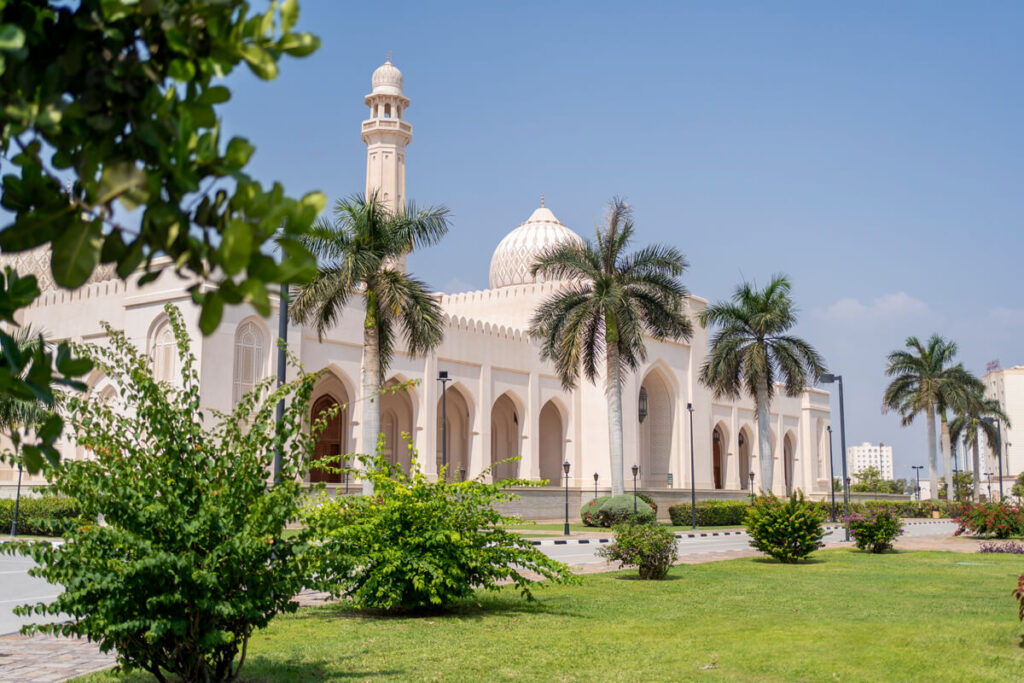
The area around Salalah is steeped in history. One highlight is the ancient port city of Sumhuram, a UNESCO World Heritage Site and an important archaeological site. Did you know that Salalah also played a central role in the historic frankincense trade? Numerous frankincense trees grow in the region, and the frankincense trade has a long tradition here. The Frankincense Museum in Salalah offers fascinating insights into this.
Our café tips:
- Moin Café (inspired by the city of Hamburg)
- Bon Lab Café (stylish café & “co-working”)
2. Hawana
We didn’t stay in Salalah itself, but rather about 20 km east in the large Hawana Salalah residential complex. There, you’ll find not only great apartments, but also several hotels, a harbor promenade, fantastic beaches, huge pool complexes, green palm trees, a few shops, restaurants, and much more. For us, it was the perfect base for our exploration of the south of the country.
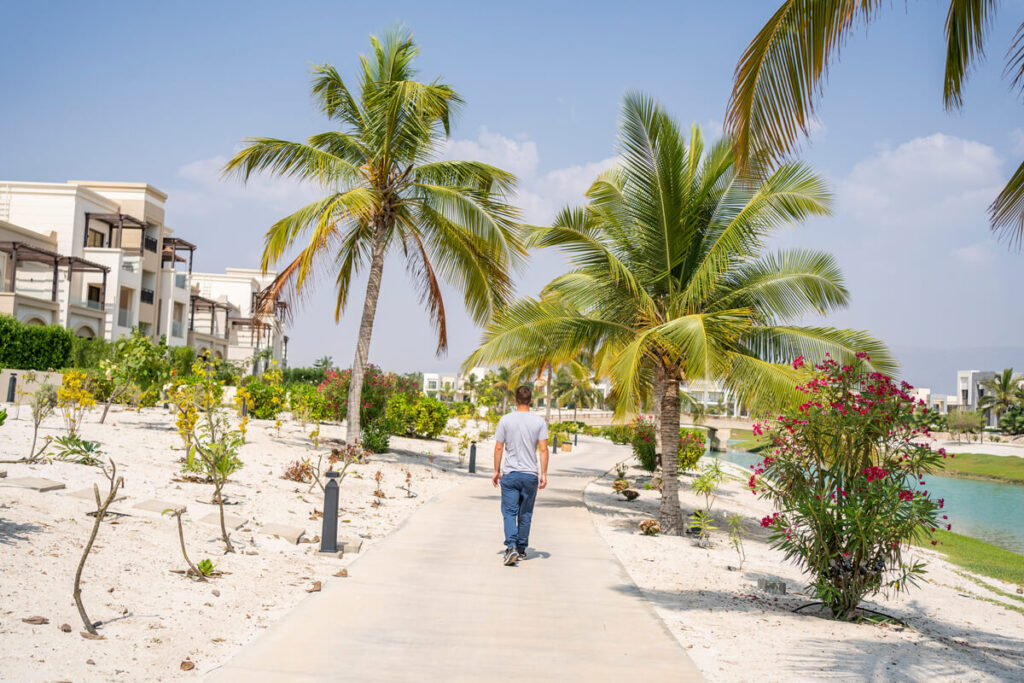
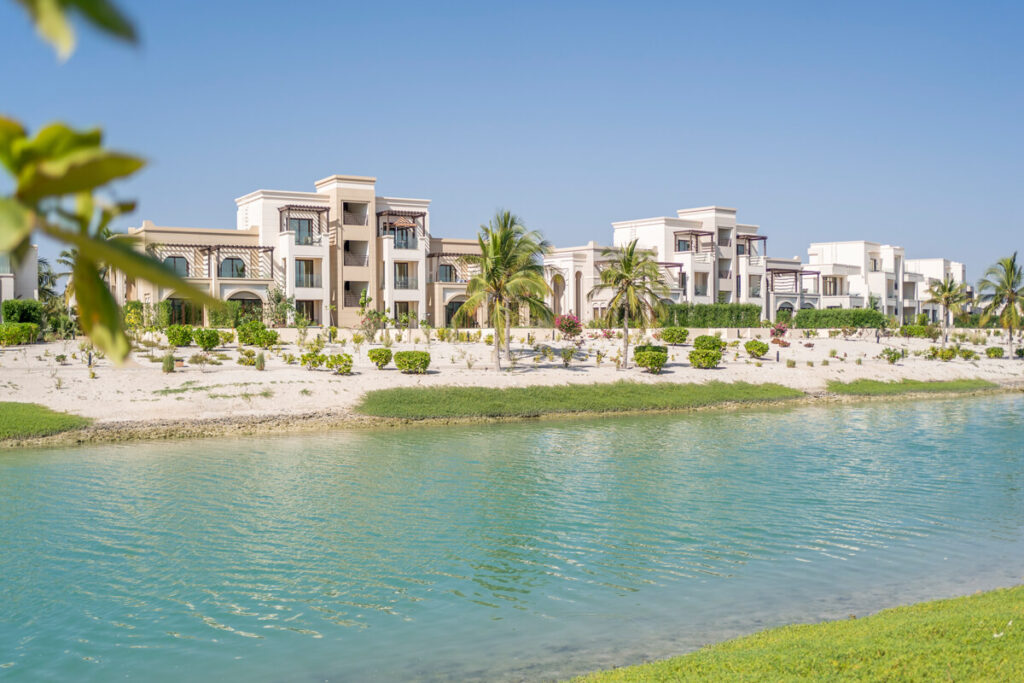
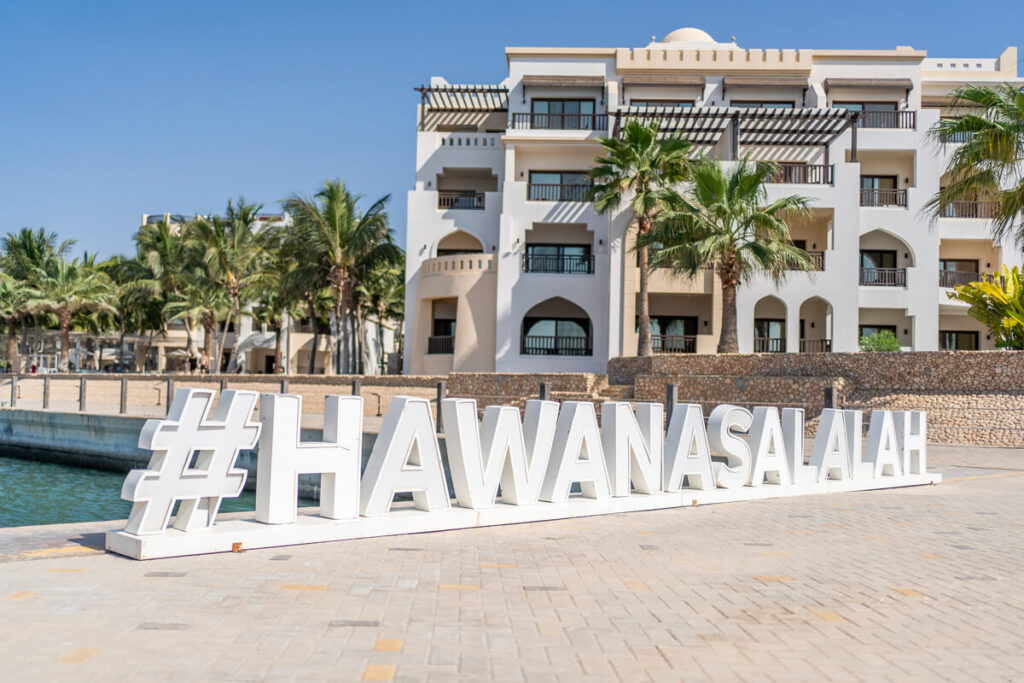
3. Al Haffa Beach & Coconut Beach
As already mentioned, there are numerous beautiful beaches around Salalah. We particularly liked Al Haffa Beach with its huge palm trees. The sand is light and soft, and the water is turquoise blue. Here, you can often see local fishermen diligently pulling their heavy nets out of the sea.
A little further along, past Coconut Beach, a modern beach promenade with restaurants, shops, and cafés is currently being built. Unfortunately, we were unable to find out when this will be completed.

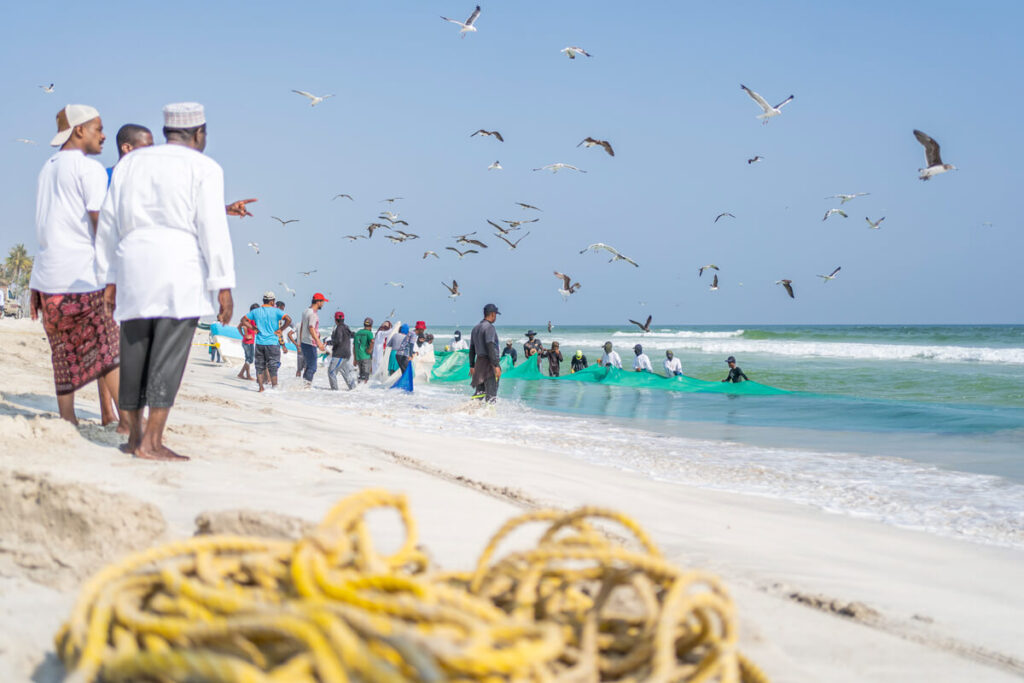
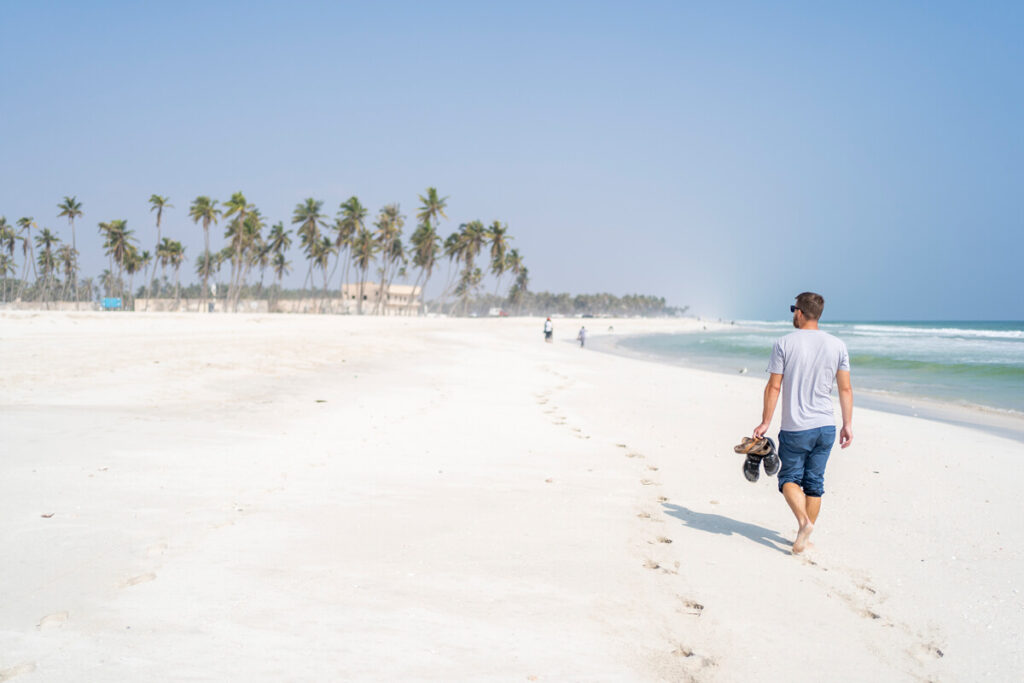
4. Mughsail Beach & Blow Holes
Mughsail Beach is located southwest of Salalah, about 40 kilometers from the city and just under 115 kilometers from the border with Yemen. The coastal scenery surrounding this beach is impressive, with rugged cliffs, golden sand, and the deep blue Arabian Sea. The area is also known for its natural bridges and caves, which were formed by the erosion of the limestone.
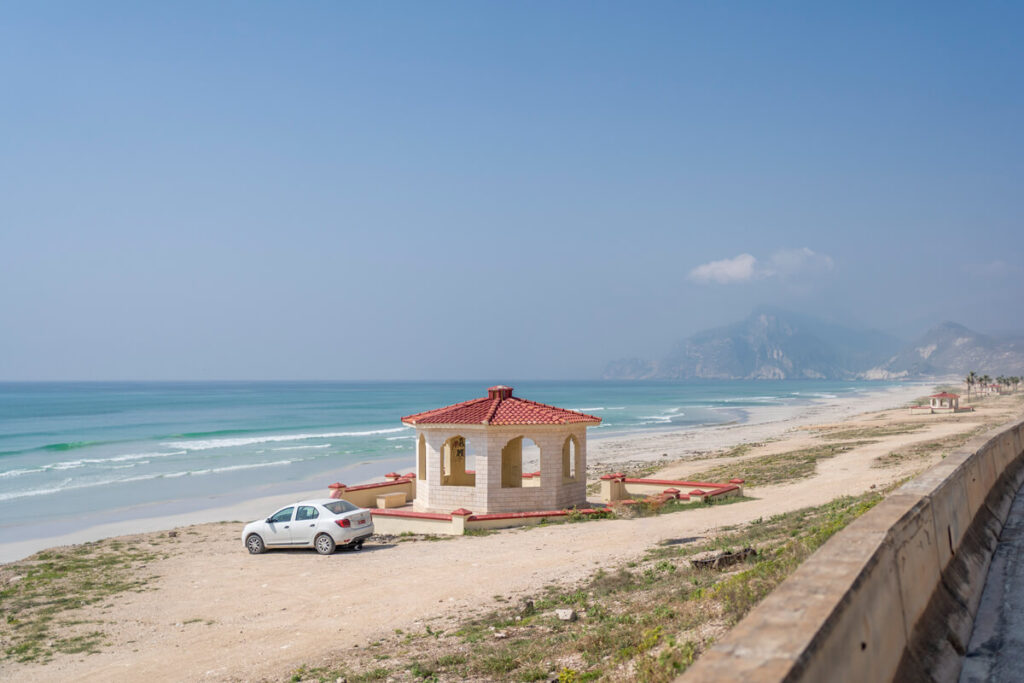

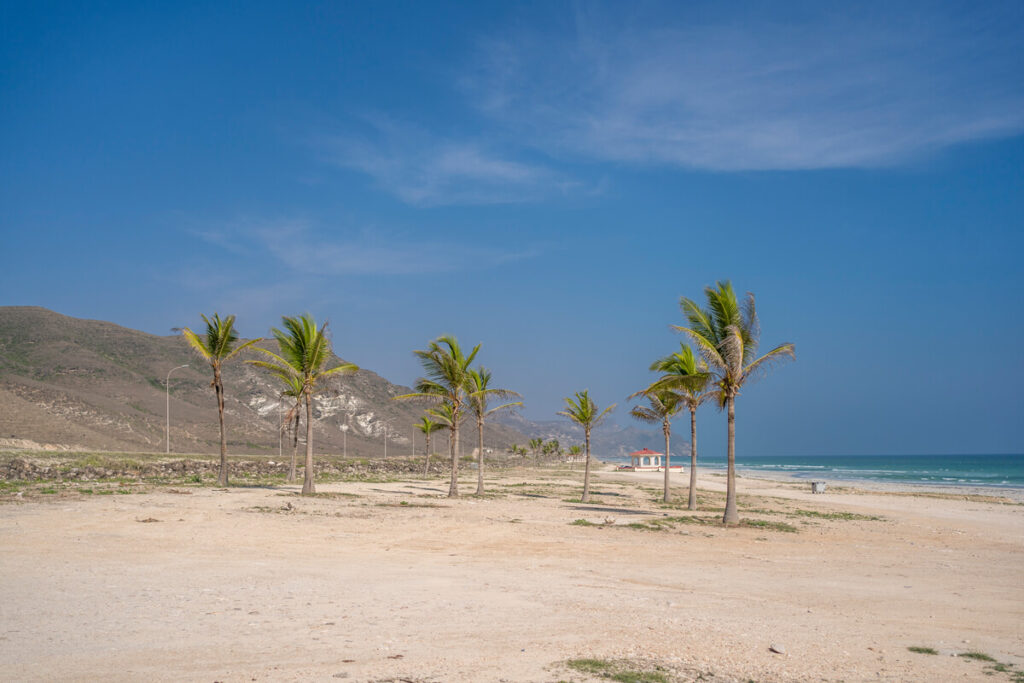
Near Mughsail Beach is the Marnif Cave, a large semi-cave formed from overhanging, heavily jagged rocks. From there, you have a fantastic view of the sea. Stroll further along the paths to the so-called “blowholes”, from which water is catapulted into the air during high swells and at high tide. This natural spectacle is said to be most impressive during the monsoon. There are great viewing platforms, picnic areas, and even a restaurant on site.
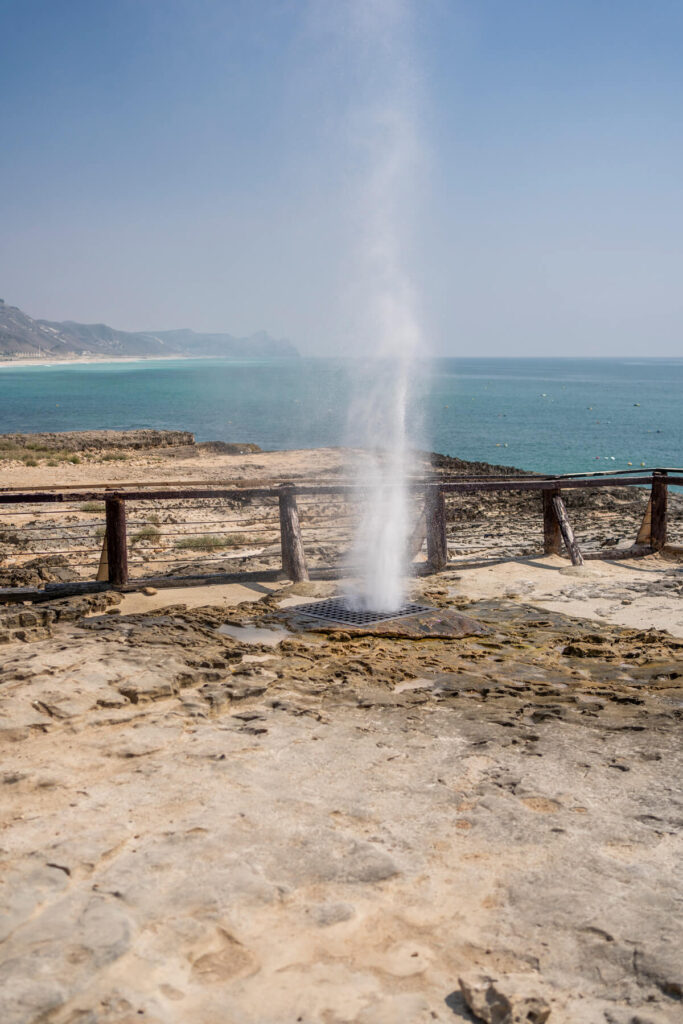
5. Fazayah Beach
If you now drive back to Road 47 from Mughsail Beach, after about 20 kilometers you will reach the beautiful Fazayah Beach. The last 5 kilometers are a steep descent from the mountains for hundreds of meters along an unpaved track to the sea.
We recommend this route only with a four-wheel drive, as a regular car might not have enough power for this distance. Once you reach the bottom, you can drive into one of the bays and jump into the sea. The beaches there are stunningly beautiful. We also saw turtles and dolphins here. Amazing!
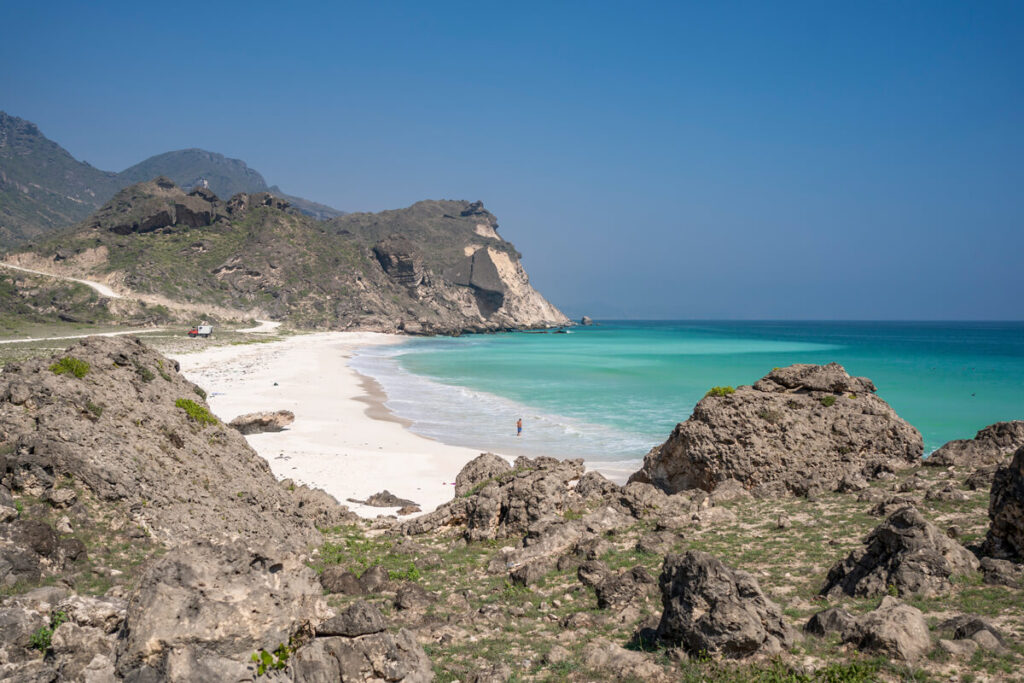
6. Wadi Darbat
Wadi Darbat, just 40 kilometers from Salalah, is one of the most popular attractions in Oman. During the Khareef season from June to September, the valley transforms into a green oasis with seasonal waterfalls and flowing streams – simply impressive!
It is also worth a visit outside of this time. We were there in November and were surprised by the picturesque landscape, which is definitely worth a stop.
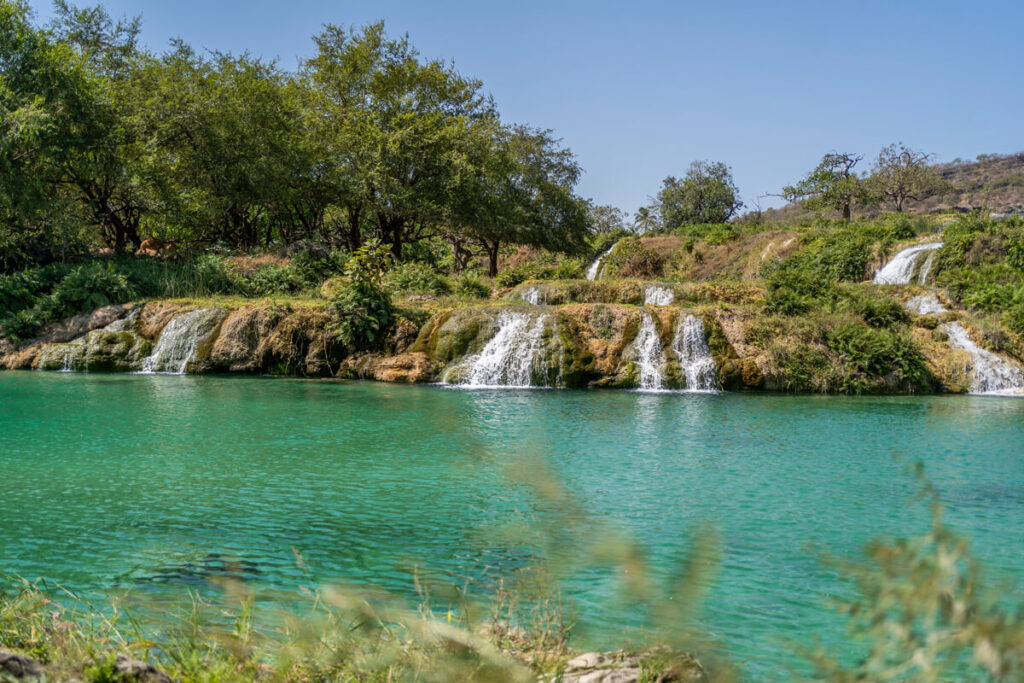
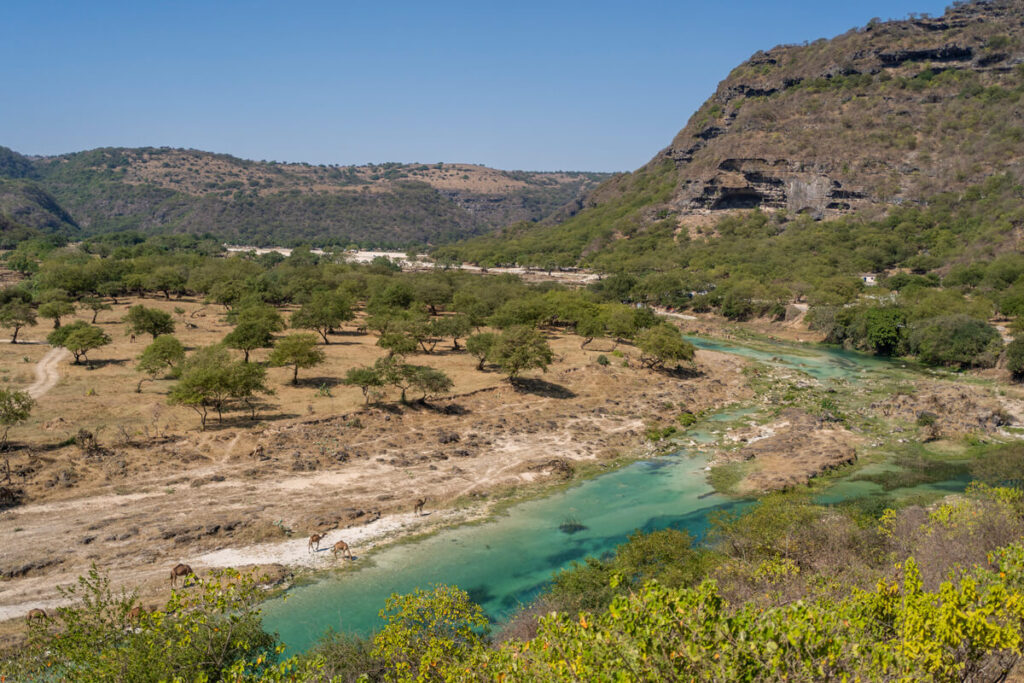

Wadi Darbat has picnic areas along the riverbank, which are ideal for a break. There are also hiking trails that allow you to explore the surrounding area. During the khareef season, you can also take boat trips on Lake Darbat, which is formed by the inflow of Wadi Darbat. You can also rent pedal boats on site (3 rials for 30 minutes).
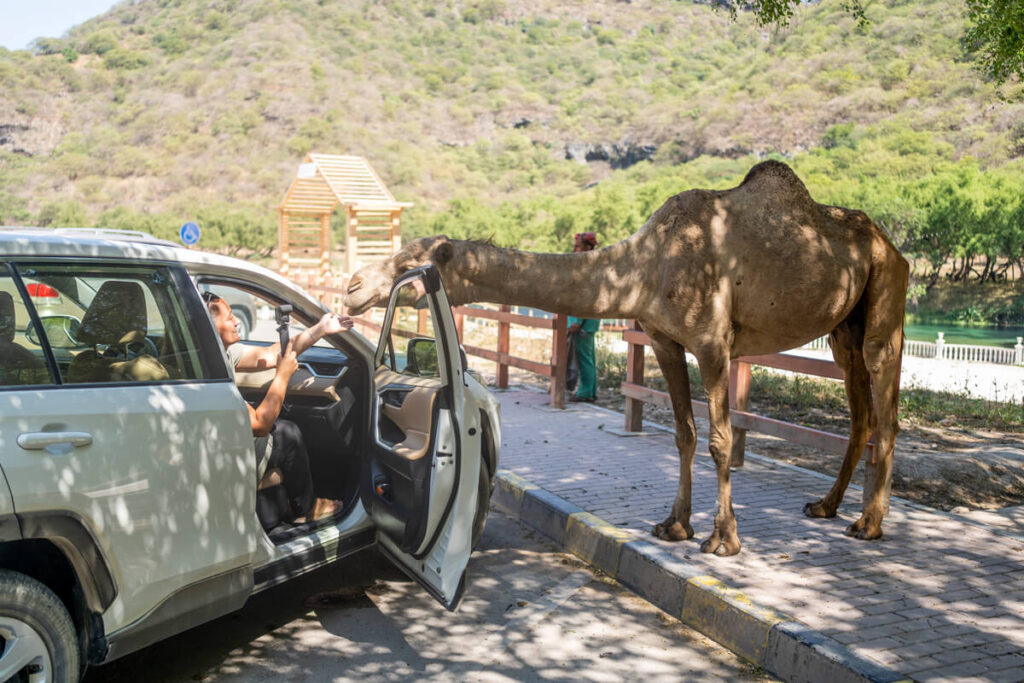
7. Taqah
The small town of Taqah is located just 30 minutes east of Salalah. The atmosphere is very quiet, sleepy, and cozy. Taqah is home not only to the small, worth-seeing Taqah Castle and the Burj Al Askar defense tower, but also to the unique Koofan Heritage House, which is a museum, hotel, café, and souvenir shop all in one. The approximately 150-year-old traditional mud and stone house has been painstakingly restored by the owner family.
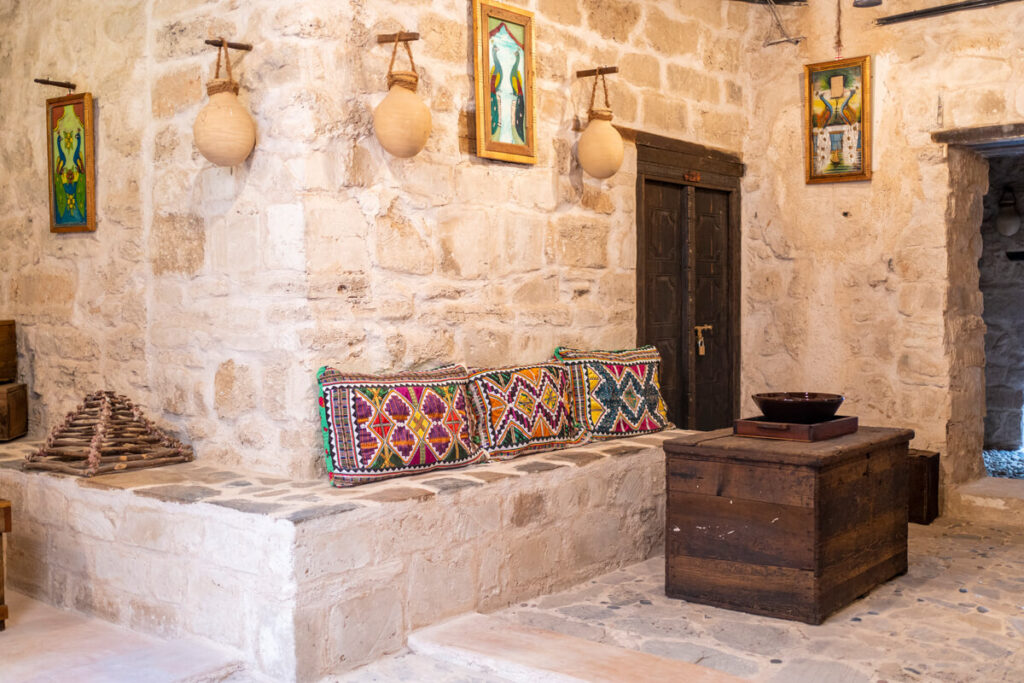
In the individual rooms, you will find numerous original objects and pieces of furniture from earlier times belonging to the family, which have been beautifully displayed here. The house has 12 individually furnished rooms and is also a small museum.
While most visitors come just for the museum (entrance fee 1 rial), we definitely recommend staying at least one night. The house is only 25 minutes from Wadi Darbat and only 5 minutes from the sea. Highly recommended! Read more here.
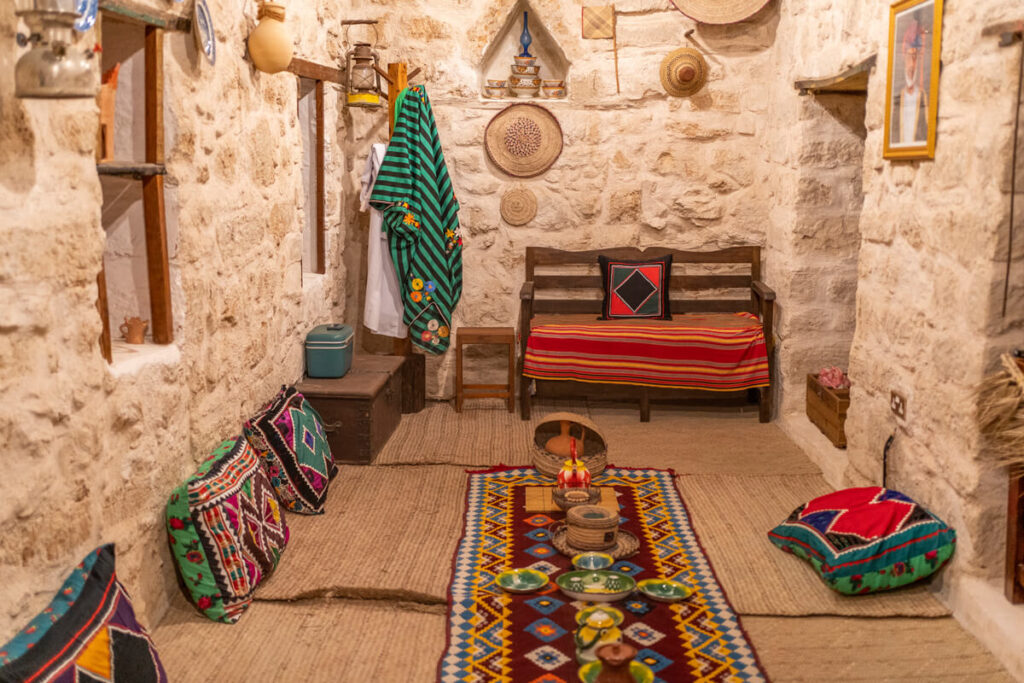
8. Fushi Beach
After 5 wonderful days in the south of the country, we slowly made our way back to the north of Oman. This time, however, we didn’t drive through the interior, but always along the coast. From Taqah, we drove via Mirbat and Sadah on Road 49.
Shortly beyond Sadah, we discovered a beach with huge sand dunes and a majestic mountain in the background. We could hardly believe our eyes, because the scenery was simply unique. Luck was on our side, as a dromedary caravan was passing through the sand dunes.
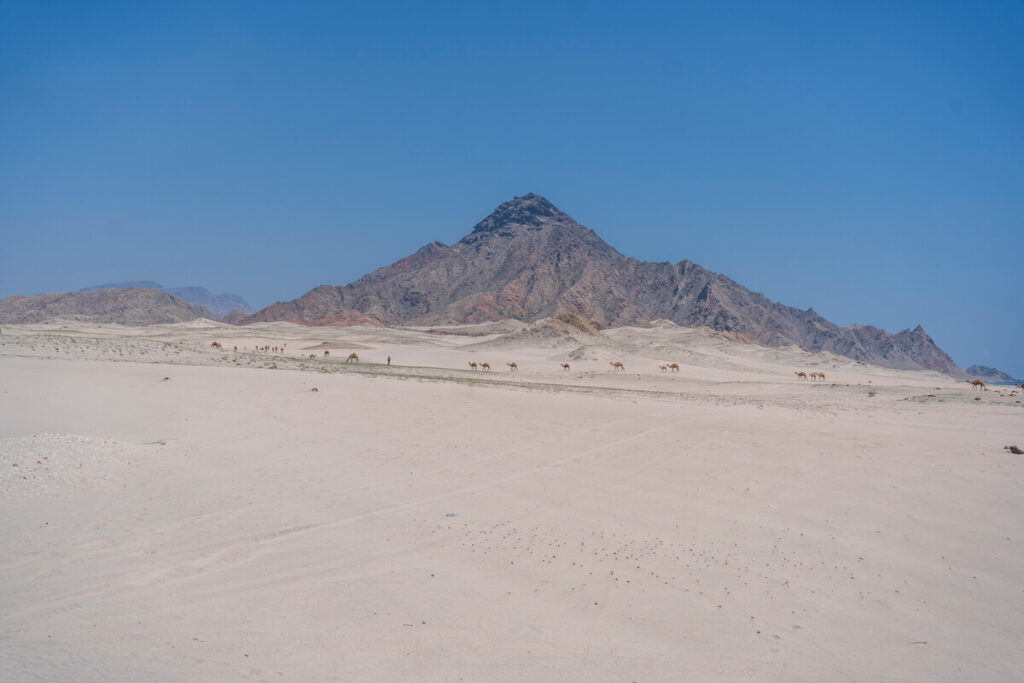
9. Oman Ocean Drive
Now comes a special highlight of our Oman tour, although we freely invented the name “Oman Ocean Drive.” But this name immediately popped into our heads as we drove along it.
After leaving Fushi Beach behind us, Road 49 led along the sea for almost 84 kilometers (from Hasik it becomes Road 42). A new, beautiful view awaited us around every corner. And the best part: there wasn’t a soul in sight except us.
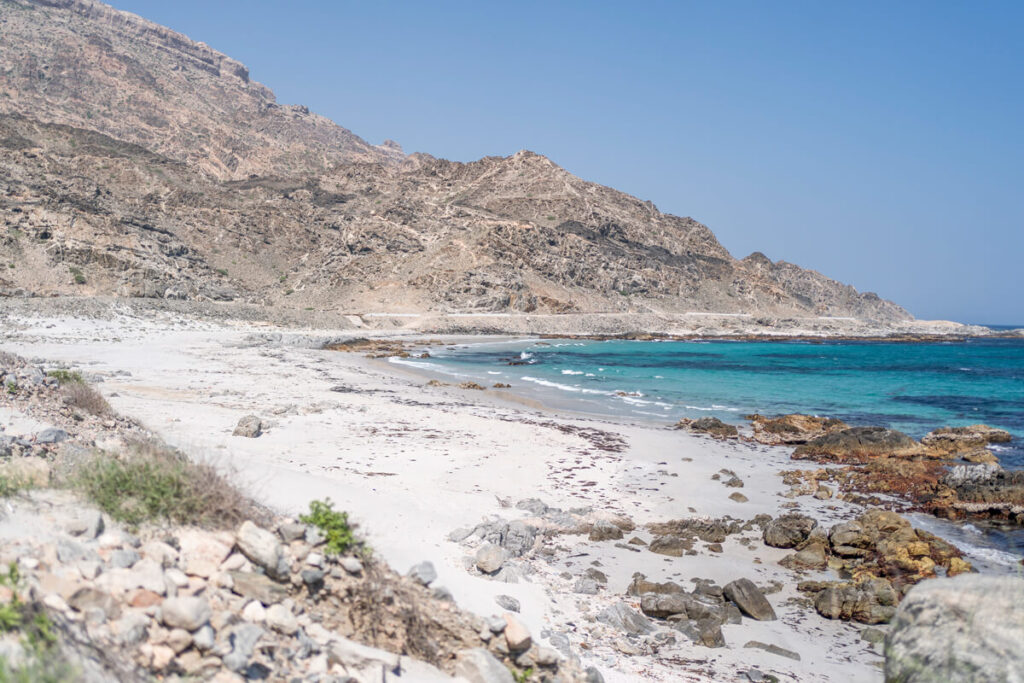
On the way, we passed stunningly beautiful beaches, such as Ras Hasik Beach and Swimmingpools Beach. We hardly saw any cars in this area, let alone people. About 10 km beyond Hasik, the road climbs back up the mountains, and you reach a fantastic vantage point.
From up there, you can look out over the turquoise sea, while the sea drops hundreds of meters below you. Of course, we immediately grabbed our binoculars and actually spotted a group of dolphins. Amazing!
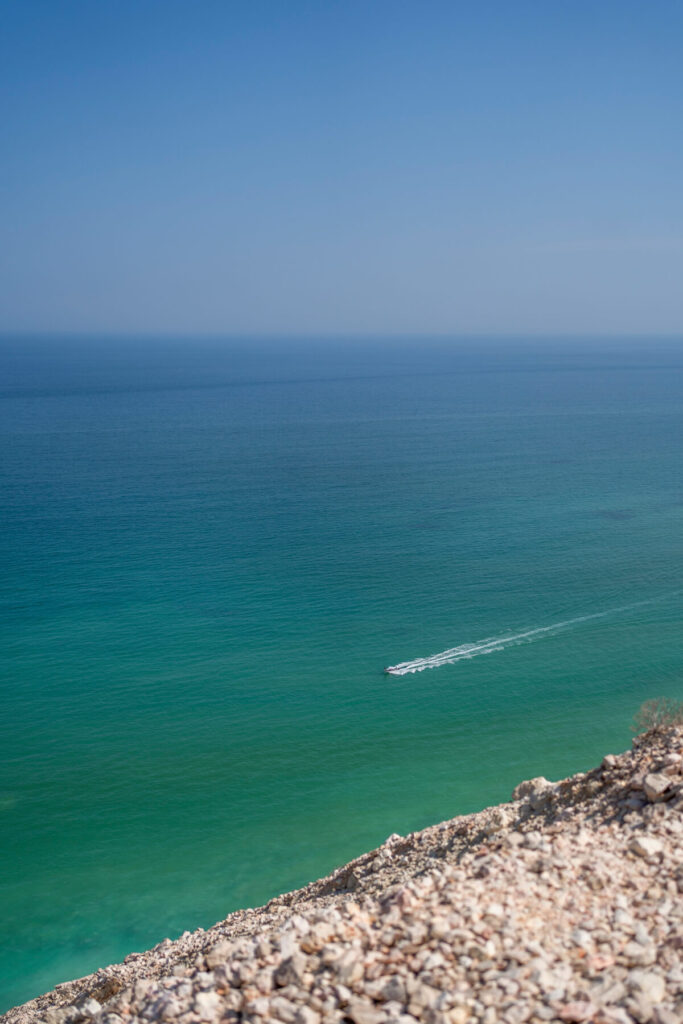
10. Canyon Viewpoint
We drove further and further down the road. Almost 40 km after the aforementioned viewpoint, we reached the Canyon Viewpoint. Naturally, we briefly turned off Road 42 and parked the car at the viewpoint on the edge of the canyon.
According to the information on the website www.mapcoordinates.net, the drop was about 400 meters below us. The view is truly spectacular and once again demonstrated to us how diverse Oman is. You’ve just driven past a beautiful beach and the next moment you’re standing at the edge of an impressive canyon. Wow!
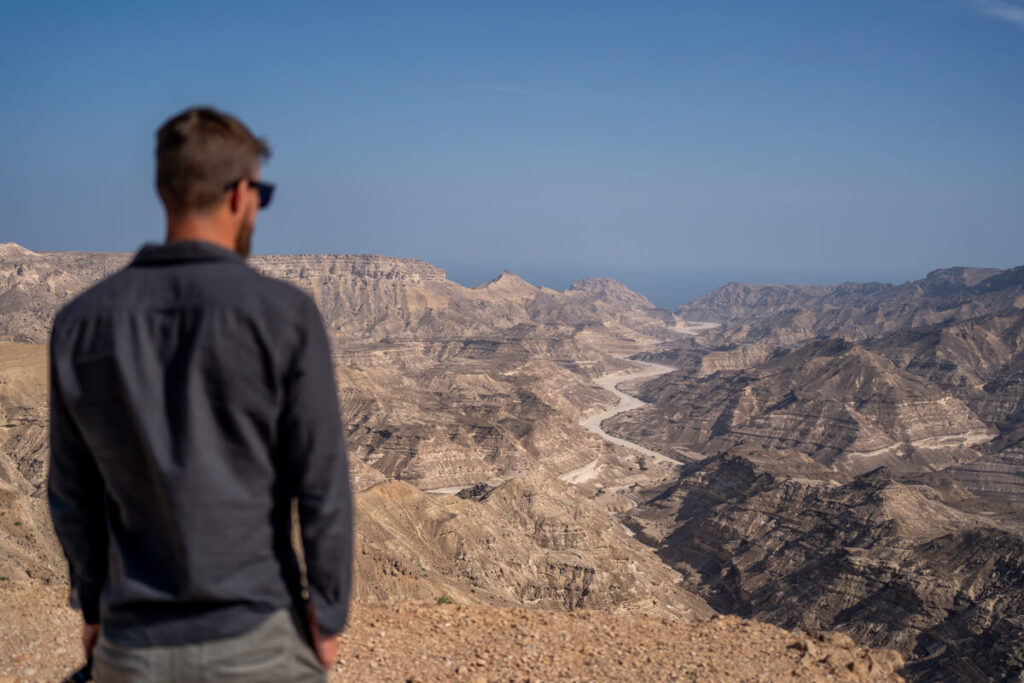
Our Conclusion on the Oman Trip
As you’ve now learned, Oman offers an incredible number of sights and highlights. If you have at least 14 days (18-21 days is better), we recommend a tour of the country. You’ll surely be just as impressed by its many different facets as we were.
Our tour of Oman is by far one of the most beautiful trips we’ve ever taken. The country impressed us not only with its diversity, but above all with the hospitality of its people. We sincerely hope you enjoyed this article and that it helps you with your travel planning.
Little Oman FAQ
When is the best time to travel to Oman? Do I need a 4×4? Is Oman an expensive travel destination? How much does a trip through Oman cost? Is Oman a safe travel destination? Can I travel through Oman alone as a woman?